
What's Yours Is Mine: Against the Sharing Economy
by
Tom Slee
Published 18 Nov 2015
Accessed May 20, 2015. http://blog.usaid.gov/2012/05/food-security-open-data-challenge/. Open Knowledge Foundation. “What Is Open?” Open Knowledge Foundation. Accessed May 18, 2015. https://okfn.org/opendata/. O’Reilly, Tim. “Networks and the Nature of the Firm.” Medium, August 14, 2015. https://medium.com/the-wtf-economy/networks-and-the-nature-of-the-firm-28790b6afdcc. Ostrom, Elinor. Governing the Commons: The Evolution of Institutions for Collective Action. The Cambridge Series on the Political Economy of Institutions. Cambridge University Press, 1990. Owyang, Jeremiah. “The Collaborative Sharing Economy Has Created 17 Billion-Dollar Companies (and 10 Unicorns).”
…
Who would have thought even five years ago that a world-class operating system could coalesce as if by magic out of part-time hacking by several thousand developers scattered all over the planet, connected only by the tenuous strands of the Internet? 2 The success of Linux and other open source software projects spurred a wave of optimism about a fundamentally new way of creating complex products by relying on networks of peers. Yochai Benkler made an academic case for peer networks in his essay “Coase’s Penguin: Linux and the Nature of the Firm” and then in his influential book The Wealth of Networks, holding up Linux as the archetype of a new form of production that could reshape economies.3 The traditional economy is driven, in this view, by markets and by hierarchical firms or state organizations, but Benkler saw a third possibility, which he labeled “commons-based peer production.”
…
Benjamin, Solomon, Bhuvaneswari Raman, P. Rajan, and B. Manjunath. “Bhoomi: ‘E-Governance’, Or, An Anti-Politics Machine Necessary to Globalize Bangalore?” CASUM-M Working Paper. Bangalore: International Institute of Information Technology, 2005. Benkler, Yochai. “Coase’s Penguin, or Linux and the Nature of the Firm.” Computing Research Repository cs.CY/0109 (2001). ———. The Wealth of Networks: How Social Production Transforms Markets and Freedom. New Haven; London: Yale University Press, 2006. Bercovici, Jeff. “Uber’s Ratings Terrorize Drivers And Trick Riders. Why Not Fix Them?” Forbes, August 14, 2014. http://www.forbes.com/sites/jeffbercovici/2014/08/14/what-are-we-actually-rating-when-we-rate-other-people/.

Machine, Platform, Crowd: Harnessing Our Digital Future
by
Andrew McAfee
and
Erik Brynjolfsson
Published 26 Jun 2017
Spode, “The Great Cryptocurrency Heist,” Aeon, February 14, 2017, https://aeon.co/essays/trust-the-inside-story-of-the-rise-and-fall-of-ethereum. 305 “In [minority members’] view”: Ibid. 305 “Ethereum Classic”: Ibid. 306 “The Resolution of the Bitcoin Experiment”: Mike Hearn, “The Resolution of the Bitcoin Experiment,” Mike’s blog, January 14, 2016, https://blog.plan99.net/the-resolution-of-the-bitcoin-experiment-dabb30201f7#.rvh0ditgj. 306 “It has failed because the community has failed”: Ibid. 306 the performance of the Bitcoin system suffered: Daniel Palmer, “Scalability Debate Continues as Bitcoin XT Proposal Stalls,” CoinDesk, January 11, 2016, http://www.coindesk.com/scalability-debate-bitcoin-xt-proposal-stalls. 306 Chinese exchanges accounted for 42%: Nathaniel Popper, “How China Took Center Stage in Bitcoin’s Civil War,” New York Times, June 29, 2016, https://www.nytimes.com/2016/07/03/business/dealbook/bitcoin-china.html. 306 an estimated 70% of all Bitcoin-mining gear: Danny Vincent, “We Looked inside a Secret Chinese Bitcoin Mine,” BBC News, May 4, 2016, http://www.bbc.com/future/story/20160504-we-looked-inside-a-secret-chinese-bitcoin-mine. 308 “a kid in Africa with a smartphone”: Brandon Griggs, “Futurist: We’ll Someday Accept Computers as Human,” CNN, March 12, 2012, http://www.cnn.com/2012/03/12/tech/innovation/ray-kurzweil-sxsw. 309 “The Nature of the Firm”: R. H. Coase, “The Nature of the Firm,” Economica 4, no. 16 (1937): 386–405, http://www.richschwinn.com/richschwinn/index/teaching/past%20courses/Econ%20340%20-%20Managerial%20Economics/2013%20Fall%20340%20-%20The%20Nature%20of%20the%20Firm.pdf. 311 “Electronic Markets and Electronic Hierarchies”: Thomas W.
…
What does economic theory and evidence have to say about how tech progress changes companies and other ways we organize to get work done? Quite a lot, actually. . . . Meet the Economics of the Firm In November 1937, when he was just twenty-six, the economist Ronald Coase published his landmark paper “The Nature of the Firm.” In it, he posed a very basic question: If markets are so great, why does so much happen inside companies? Why, in other words, do we choose to conduct so much economic activity within these stable, hierarchical, often large and bureaucratic structures called companies, rather than just all working as independent freelancers, coming together as needed and for only as long as necessary to complete a particular project, then going our own way afterward?
…
It’s easy to see why a pure, atomistic market wouldn’t work in an environment where business law was underdeveloped, courts were weak, and contracts therefore could not be trusted. But this was not the case in the United States and the other advanced economies of the 1930s. So, why so many companies? Coase’s analysis of this question proves again how right Keynes was about the enduring influence of dead economists: “The Nature of the Firm” is frequently cited by geeks and technologists. In fact, it’s almost the only economics paper we’ve heard them mention. We’re amazed at how often we’ve heard Coase’s name invoked by digital entrepreneurs, innovators, and futurists. But we probably shouldn’t be, because he indicated to them how important their work could be, and how it could reshape entire economies.# Coase’s Choice: Organization or Market?
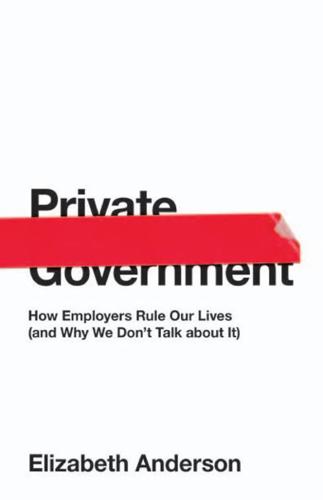
Private Government: How Employers Rule Our Lives (And Why We Don't Talk About It)
by
Elizabeth S. Anderson
Published 22 May 2017
So what new evils does the “government” of the firm really add? Anderson’s lecture suggests, to my mind, two main answers. The first might be labeled “abuse of power”—or, better, “use of an unjustified power.” Grant that there is a sound economic justification, of the kind pioneered by R. H. Coase, “The Nature of the Firm,” for having firms.5 At least when firms are complemented with other institutions, it works to everyone’s benefit to have them. And to have firms is, in part, to give certain people certain powers over others within the firm. The concern is that, unless care is taken, in giving those people those justified powers, we also give them unjustified powers.
…
Smith, Wealth of Nations, vol. 2, V.1.F.50. 100. Smith, Theory of Moral Sentiments, I.3.3.1. Chapter 2 1. This is true of the corporate form. Legally, the corporation, not the shareholders, owns the firm’s assets. In a partnership, an oligarchy governs and owns all the assets. 2. R. H. Coase, “The Nature of the Firm,” Economica 4, no. 16 (1937): 386–405. 3. Eugene Volokh, “Private Employees’ Speech and Political Activity: Statutory Protection against Employer Retaliation” (2012), http://ssrn.com/abstract=2174776. 4. Ken Cuccinelli, The Last Line of Defense: The New Fight for American Liberty (New York: Crown Forum, 2013), 52, 231. 5.
…
For the required contrast, we have to imagine that piecework, perhaps contrary to fact, wasn’t like this. This makes the thought experiment no longer so “natural.” 4. Frederick Winslow Taylor, The Principles of Scientific Management (New York and London: Harper & Brothers, 1911). 5. R. H. Coase, “The Nature of the Firm,” Economica 4 (1937): 386–405. 6. Granted, this worry may not be limited to the firm. A monopsonist might threaten to refuse to do business with an independent artisan, unless he votes for his candidate. But, at very least, the worry is not a worry about compensation, conditions, or security.

Big Business: A Love Letter to an American Anti-Hero
by
Tyler Cowen
Published 8 Apr 2019
I’ve found that over time my views on exactly what a corporation is and what it does have evolved away from the economics mainstream. I’m more likely to think of a corporation as a carrier of reputation and a kind of metaphorical personhood, and less likely to think of a corporation as a means of minimizing transactions costs, as many mainstream economists have suggested. In a famous 1937 article, “The Nature of the Firm,” the economist and Nobel laureate Ronald Coase defined the nature of economic thought about the corporation for many decades to come. In that piece, he described the corporation as essentially a means of reducing transactions costs. It’s not always easy to hire the worker you want just by going out into spot labor markets, not to mention get that worker to do your bidding.
…
I observe innovative, transactions-cost-reducing contracts being used within firms and also with external partners, and I am not sure where to draw the line between firm and market in terms of the parameters specified by Coase’s and Williamson’s theories. Drawing the line between firm and market legally in terms of liability and the like is much easier, but that reliance on a legal distinction should give us some clues about the best way to think about the nature of the firm—namely, as a carrier of social reputation and legal responsibility. So in lieu of the Coase and Williamson transactions-costs approach, I typically view a corporation in terms of the following properties: 1. It is a collection of assets, assembled at favorable purchase prices (or at least the prices were favorable for the case of successful corporations). 2.
…
At the same time, those bureaucracies keep some of the employees from “going off the reservation,” or make it harder for the boss to play favorites or for shareholders to use the company for personal purposes. So corporate bureaucracy is necessary. Still, because of bureaucracy, corporate life can be tough and also deeply unfair at times. And that too is “the nature of the firm,” to refer back to Ronald Coase’s title. ACKNOWLEDGMENTS The author wishes to thank Tim Bartlett, Christina Cacioppo, Bryan Caplan, Natasha Cowen, Teresa Hartnett, Daniel Klein, Ezra Klein, Randall Kroszner, Timothy Lee, Hollis Robbins, Alex Tabarrok, and Dillon Tauzin for useful comments and discussions and assistance.
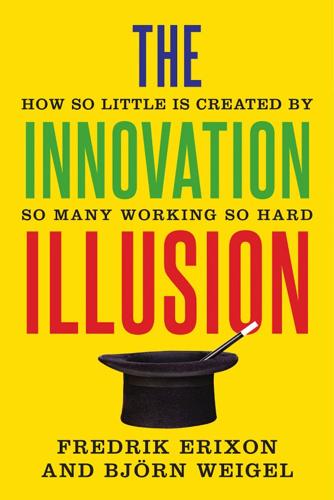
The Innovation Illusion: How So Little Is Created by So Many Working So Hard
by
Fredrik Erixon
and
Bjorn Weigel
Published 3 Oct 2016
; Cecchetti and Kharroubi, “Reassessing the Impact of Finance on Growth.” 57.Swagel, “The Financial Crisis.” 58.Cecchetti and Kharroubi, “Why Growth in Finance Is a Drag on the Real Economy.” 59.Christensen, Kaufman, and Shih, “Innovation Killers,” 1–2. 60.Piketty, Capital in the Twenty-First Century, 264–81. 4 The Rise and Rise Again of Corporate Managerialism 1.Martti, Nokia: The Inside Story. 2.Steinbock, The Nokia Revolution. 3.Ahmad, Nokia’s Smartphone Problem. 4.Kuittinen, “Nokia Sells Handset Business to Microsoft.” 5.Lomas, “Nokia’s $7.2BN Devices & Services Exit.” 6.Cheng, “It’s Official: Motorola Mobility Now Belongs to Lenovo.” 7.Bass, “Microsoft’s Concept Videos.” 8.Jenkins, “Jenkins: Only Bill Gates Can Change Microsoft.” 9.Yarow, “Here’s What Steve Ballmer Thought about the iPhone.” 10.A good survey of companies failing at exits is McGrath, The End of Competitive Advantage. 11.Steinberg, “Among the First to Fall at I.B.M.” 12.Crainer, “‘Saving Big Blue.’” 13.Clinch, “How Apple Prompted This Country’s Downgrade.” 14.Schumpeter, Capitalism, Socialism and Democracy, 132. 15.Coase, “The Nature of the Firm,” 388. 16.Oliver Williamson, who received the Nobel Prize in economics for his work on economic governance, developed the idea of firm boundaries and put the emphasis on the internal or endogenous capacity of the firm to generate output that is more competitive than the market. 17.Santos and Eisenhardt, “Organizational Boundaries and Theories of Organization,” 491. 18.Coase, “The Nature of the Firm,” 390. 19.Coase, “The Nature of the Firm,” 404–5. 20.Zenger, Felin, and Bigelow, “Theories of the Firm–Market Boundary.” 21.Tett, The Silo Effect. 22.Morieux, “How Too Many Rules at Work Keep You from Getting Things Done.” 23.See, for instance, Caliendo and Rossi-Hansberg, “The Impact of Trade on Organization and Productivity.” 24.Zhou, “Coordination Costs, Organization Structure and Firm Growth.” 25.Langlois and Everett, “Complexity, Genuine Uncertainty, and the Economics of Organization”; Joskow, “Vertical Integration.” 26.Strom, “Big Companies Pay Later.” 27.Rajan and Zingales, “The Firm as a Dedicated Hierarchy.” 28.Bhide, The Origin and Evolution of New Business, 94. 29.Rajan and Zingales, “The Firm as a Dedicated Hierarchy,” 7. 30.Teece, “Profiting from Technological Innovation.” 31.Jensen, “Agency Cost of Free Cash Flow, Corporate Finance, and Takeovers.” 32.Stein, “Agency, Information and Corporate Investment”; Matvos and Seru, “Resource Allocation within Firms.” 33.See Berger and Ofek, “Diversification’s Effect on Firm Value”; Rajan, Servaes, and Zingales, “The Cost of Diversity.” 34.Scharfstein and Stein, “The Dark Side of Internal Capital Markets.” 35.Scharfstein and Stein.
…
Corporate managerialism: ideology on the rise Coase’s philosophy is the start, not the end, of an inquiry into the rise of corporate managerialism, the economics of organizations, and how companies set the boundaries of the firm. Those that are academically minded will know that there is a heated debate about the nature of the firm, with different schools of thoughts.20 Yet Coase’s basic concept is irrefutably simple and it is easy to see how it immediately manifests in companies through organization, coordination, and agency costs. To manage increasing complexity, a big company needs to organize itself into divisions and subgroups, but those often turn into silos that sometimes get so entrenched that the left hand does not know what the right hand is doing.
…
Clark, Gregory A., A Farewell to Alms: A Brief Economic History of the World. Princeton University Press, 2009. Clinch, Matt, “How Apple Prompted This Country’s Downgrade.” CNBC, Oct. 13, 2014. At http://www.cnbc.com/2014/10/13/how-apple-prompted-this-countrys-downgrade.html. Coase, Ronald H., “The Nature of the Firm.” Economica, 4.16 (1937): 386–405. Coase, Ronald, and Ning Wang, How China Became Capitalist. Palgrave Macmillan, 2012. Coldwell, Will, “Airbnb’s Legal Troubles: What Are the Issues?” Guardian, July 8, 2014. At http://www.theguardian.com/travel/2014/jul/08/airbnb-legal-troubles-what-are-the-issues.

Why Information Grows: The Evolution of Order, From Atoms to Economies
by
Cesar Hidalgo
Published 1 Jun 2015
Transaction cost theory, or new institutional economics, is the branch of economics that studies the costs of transactions and the institutions that people develop to govern them. In simpler terms, it is the branch studying the cost of economic links and the ways in which people organize to deal with commercial interactions. The origins of transaction cost theory can be traced back to a 1937 paper by Ronald Coase, “The Nature of the Firm.”4 As a young scholar, Coase realized that the descriptions of the economy that were prevalent at the time tended to overlook one aspect of the economy that seemed obvious to him: the fact that economic transactions are costly. As a student at the London School of Economics, Coase attended a seminar organized by Arnold Plant, who had been recently appointed as a professor of commerce.5 It was there that Coase heard a description of the economy that contradicted his intuition and would accompany his thoughts throughout his life.
…
Yet, even firms with infinitely deep pockets will at some point bump into a finite knowledge carrying capacity, which (in agreement with Ronald Coase’s theory of the firm, which we will review later in this chapter) will be expressed in the price difference between doing an activity internally and hiring it from the market. 4. Ronald H. Coase, “The Nature of the Firm,” Economica 4, no. 16 (1937): 386–405. We could also use as a starting point John R. Commons’ “Institutional Economics,” American Economic Review 21 (1931): 648–657. Transaction cost theory, institutional economics, and its younger and uninspiredly named cousin, new institutional economics, study the interactions between economic agents, the decisions that push agents to interact, and the contracts and governance structures mediating those interactions.
…
See Crystallized imagination Incentives, as production stimulus, 77–78 India, economic growth in, 159 Individual limits on accumulation of knowledge and knowhow, 79–81, 82, 83–85, 179, 180 Indonesia, 161 Industrial development/diversification, personbyte theory and, 139, 142–144 Industrial structure and size, trust and, 115–116 Industries, geographic distribution of, 130–132 Industry-location matrices, nestedness of, 132–136, 139, 142–143 Industry space, 139, 141 Information ability to process, 35–37 behind chaos, 30–31 Boltzmann and, xiii computation of, 23–24 conceptual aspects of, xv–xvi connection with knowhow, 165–169 contained in tweet, 13–14 decoding, 23 in DNA, 5, 22–23, 34, 166–168, 176 embedded in objects, 5–6, 8, 11–13, 43–44, 45, 178 embedded in solids, 33–35, 176 embodied in product, source of, 62–63 emerging from out-of-equilibrium systems, 28–33, 35, 175 energy and, 175, 177 entropy and, 14–15 environmental conditions conducive to growth of, 176–177 evolution of, xix–xx irreversibility of time and, 26 mathematical study of, xiii–xiv meaning vs., xvi–xvii physical nature of, xvii–xxi as physical order, xv, xix, 5, 7–8 physical origins of, 28–35 sciences and, xiv Shannon’s theory of, xv–xvii, 13–15, 17–18, 19–20 social sciences and, xiv–xv as something and about something, 7 “stickiness” of, 31–35 Information growth computational ability of matter and, 35–37, 41, 176, 177–178, 181 computational capacity as constraint on, 75 economy as system of, 8–9, 177–180 entropy and, ix, xx history of universe and humans and, xviii–xix nineteenth-century physics and, 26–28 Information processing, as purpose of life, 43–44 Information-rich states, 18–24 properties of, 22–23 Information-rich steady states, out-of-equilibrium systems and, 29–31 Information theorists (cyberneticists), xiv Information theory, xv–xvi Innovative economic sectors, adaptability of firms and, 124 Instantaneous nature of reality, 40 Institutions new institutional economics, 89–91, 93, 117–118, 123 social networks and, 44–45 See also Social institutions Intel, 92, 95 International trade, product exports as crystallized imagination, 51–55 Internet, 92 iPads, 50 iPhones, 50, 92 iPods, 92 Irreversibility of time, in statistical system, 37–40 Italy, familial networks in, 122 Ito, Joi, 73 James, LeBron, 130 Jamestown colony, 170 Japan, formation of large networks in, 115, 116 Jet engine production, 154–155 Jigsaw puzzle analogy, 135–136 Jobs, social networks and, 112–114 Jobs, Steve, 65, 92, 119–120, 142 Joule, James, 60 Just, Sándor, 59 Kauffman, Stuart, 37 Kingston, 92 Knowhow, xviii connection with information, 165–169 as constraint on spread of economic development, 169–171 crystals of imagination and, 61 defined, 6–7, 165 embedded in networks, in economies, 167–169 embodied in biological organisms, 166–168 embodied in products, 52–55, 65–71 geographic distribution of, 77, 80–81, 127–128 information processing and, 35–36 objects and, 8, 41 physical embodiment of, 73–74 quantization of, 73–75, 87–88 social isolation and loss of, 169–171 value of, 61–62 Knowledge, xviii accumulation of, 79–85 creation of complex products and, 78–79 crystals of imagination and, 61 defined, 6 difficulty of accumulating in networks, 106–108 embodied in human networks, 179–180 embodied in products, 52–55, 78–79 genetic factors modulating ability to accumulate, 84 geographic distribution of, 77, 80–81, 127–128 human capital and, 152 industrial development and accumulation of, 139, 142 objects and, 8, 41 physical embodiment of, 73–74 products and practical use of, 65–71 quantization of, 87–88 sharing practical uses of, 69–70 tacit, 78 value of, 61–62 volumes contained in manufacturing networks, 105, 106–107 See also Personbytes Korea, balance of trade with Chile, 52, 54–55 Kuznets, Simon, 146–147, 149 Labor, economic growth and, 146 Labor markets, social networks and, 112–114, 121, 124 Landry, Dave, 139 Language, cost of interactions and, 100–101 Latin America, familial societies in, 115, 122 Law of induction, 59, 69 Learning experiential, 79–80, 81 social nature of, 80–81 Leontief, Wassily, 147, 148, 155, 162 Life ability to compute and, 37 non-equilibrium systems and, 32–33 purpose of, 43–44 Light bulb, invention of, 59 Lovelace, Ada, 49, 69 Low-trust familial societies, family networks and, 120, 121–123 Lyell, Charles, 27 Mach, Ernst, xii Machinarium, 92 Malaysia, export structure of, 137–139, 140 Managed by the Markets (Davis), 101 Mankiw, Gregory, 148 Manufacturing,, migration from United States to China, 161–162 Manufacturing networks Barbie doll, 101–102 as dominant model of production, 105 exchange of intermediate products in, 105–106 personal computer, 92, 105 volumes of knowledge and knowhow in, 105 Market interactions, cost of, 95, 100 language and, 100–101 Markets, coevolution of standards with, 100 Mathematical study of information, xiii–xiv The Mathematical Theory of Communication (Shannon & Weaver), xv–xvi Matter, computational capacities of, 35–37, 41, 176, 177–178, 181 Maxwell, James C., 28, 69 Meaning, information vs., xvi–xvii Medicinal pills, context and value of, 63–64 Melanesians, 170 Message, minimum volume of data needed to specify, xvii, 13–15 Microsoft, 95 Microstates, entropy and, 16, 17 Minsky, Marvin, 7 MIT Media Lab, 52, 61, 62, 73 Mozart, Wolfgang, 84, 124 Multiplicity of a state, entropy and, 16–17 Music genetic factors in musical ability, 84 instruments and access to knowledge, 66–67 National Bureau of Economic Research, 113 Natural sciences, xviii “The Nature of the Firm” (Coase), 90 NEC, 95 Negroponte, Nicholas, 61–62 Nestedness of industry-location matrices, 132–136, 139, 142–143 Netgear, 92 Netherlands, exports, 132 Networks accumulation of knowledge and knowhow in, 106–108 complex computation and, 179 limits on ability to form, 74–75 personbytes accumulated in, 88–89 transferral of productive, 143 transition points in structures of, 107 See also Firms; Manufacturing networks; Professional networks; Social networks Network size, familial societies vs. high-trust societies and, 115–116 Networks of firms, 92–93 social capital and, 152 New institutional economics, 89–91, 117, 123 Newton, Isaac, 25, 40 New York Times (newspaper), 92, 113 Nicolis, 32–33 Nigeria, 161 Non-equilibrium systems life and, 32–33 steady state of, 29–30 Nonequilibrium thermodynamics, 28 Nonspecific recurrent transactions, 94 Nortel, 95 Nova Lima (Brazil), 139, 141 Nyquist, Harry, xvii Object-oriented programming, 120, 142 Objects as crystallized imagination, 44, 178–180 information embedded in, 5–6, 8, 11–13, 43–44, 45, 178 knowledge and knowhow and, 41 See also Products; Solids Observatory of Economic Complexity, 52 Occasional and specific transactions, 94 On Competition (Porter), 147–148 Optogenetics, 51, 61 Order emerging in out-of-equilibrium systems, 29–30 functions and, 63 growth of, 26–28 See also Physical order Ordered states, entropy and, 17–19, 21 Out-of-equilibrium systems computation and, 37 information emerging from, 175 information-rich steady states and, 29–31 Page, Jimmy, 70 Pakistan, economic complexity of, 157–159 Palo Alto Research Center (Xerox PARC), 119–120, 142 Panel Study of Income Dynamics, 113 Past, unreachableness of, 40 Personal computer production by network of firms, 92, 105 professional networks and, 119–120 Personbytes, 83–84, 107, 180 accumulated in networks, 88–89 available in large networks with bureaucratic burden, 103–104 defined, 82 industrial development/diversification and, 139, 142–144 migration of manufacturing and, 161–162 required to produce cars, 88 ubiquity of products and nestedness of industry-location matrices, 135 Phenotypes/genotypes analogy, 130–131, 136 Physical capital, 152 export data and diversity of, 154–156 measuring, 153–154 Physical embodiment of knowledge and knowhow, 73–74.
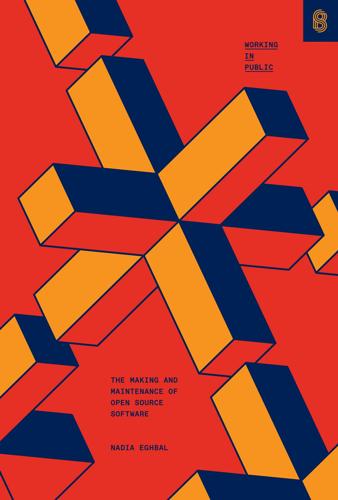
Working in Public: The Making and Maintenance of Open Source Software
by
Nadia Eghbal
Published 3 Aug 2020
Taylor, Watch Me Play: Twitch and the Rise of Game Live Streaming (Princeton, NJ: Princeton University Press, 2018), 92–93. 102 MacCallum, The Art of Community, 67. 103 Nadia Eghbal, “Emerging Models for Open Source Contributions” (presentation, GitHub CodeConf, Los Angeles, June 29, 2016), https://www.slideshare.net/NadiaEghbal/emerging-models-for-open-source-contributions. 104 Mikeal Rogers, “Healthy Open Source,” Node.js Collection, Medium, February 22, 2016, https://medium.com/the-node-js-collection/healthy-open-source-967fa8be7951. 105 Taylor Wofford, “Fuck You and Die: An Oral History of Something Awful,” Vice, April 5, 2017, https://www.vice.com/amp/en_us/article/nzg4yw/fuck-you-and-die-an-oral-history-of-something-awful. 106 Adam Rowe, “Why Paid Apps Could Be the Future of Online Communities,” Tech.co, November 1, 2019, https://tech.co/news/woolfer-paid-app-online-communities-2019-11. 107 Kevin Simler, “Border Stories,” Melting Asphalt, March 2, 2015, https://meltingasphalt.com/border-stories/. 03 108 Star Simpson (@starsandrobots), “Til recently you were online . . .,” Twitter, November 5, 2017, 6:54 p.m., https://twitter.com/starsandrobots/status/927323260244463616. 109 Ronald Coase, “The Nature of the Firm,” Economica 4, no. 16 (November 1937): 386–405, https://doi.org/10.1017/cbo9780511817410.009. 110 Elinor Ostrom, Governing the Commons: The Evolution of Institutions for Collective Action (Cambridge: Cambridge University Press, 1990), Loc 2053. 111 Yochai Benkler, “Coase’s Penguin, Or, Linux and ‘The Nature of the Firm,’” The Yale Law Journal 112, no. 3 (2002): 369–446, https://doi.org/10.2307/1562247. 112 Benkler, “Coase’s Penguin,” 381. 113 Guido van Rossum, “Foreword for ‘Programming Python’ (1st Ed.),” Python.org, May 1996, https://www.python.org/doc/essays/foreword/. 114 Linus Torvalds, “LINUX’s History,” Carnegie Mellon University School of Computer Science, July 31, 1992, https://www.cs.cmu.edu/~awb/linux.history.html. 115 Linus Torvalds, “Re: Kernel SCM Saga..,” Mailing List ARChive, April 7, 2005, https://marc.info/?
…
WHY WE PARTICIPATE IN THE COMMONS Ostrom’s work on the commons helps us understand the conditions in which people produce software collaboratively: the clubs and federations of open source. In the early 2000s, Yochai Benkler expanded upon Ostrom’s model by applying her findings to the online world. He terms this communal structure commons-based peer production (CBPP) in a 2002 essay called “Coase’s Penguin, Or, Linux and ‘The Nature of the Firm.’” (The title is a reference to Linux’s mascot, which is a penguin; in the paper, Benkler leans heavily upon the example of open source software to make his case.) Benkler observed that people were collaborating online for seemingly no obvious reason beyond personal satisfaction. He tried to understand how and why people would do this outside of Coase’s firm (i.e., in their spare time), given that it should be more transactionally expensive.
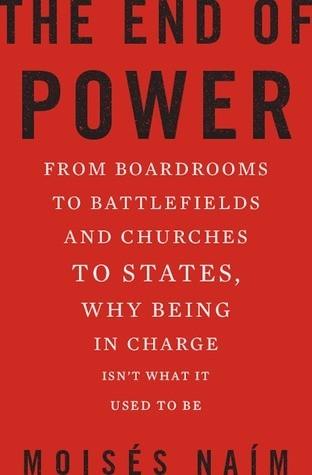
The End of Power: From Boardrooms to Battlefields and Churches to States, Why Being in Charge Isn’t What It Used to Be
by
Moises Naim
Published 5 Mar 2013
In 1937, Coase produced a conceptual breakthrough that explained why large organizations were not just rational according to a certain theory of profit-maximizing behavior but, indeed, often proved more efficient than the alternatives. It was no coincidence that, while still an undergraduate, in 1931–1932, Coase carried out the research for his seminal paper, “The Nature of the Firm,” in the United States. Earlier he had flirted with socialism, and he became intrigued by the similarities in organization between American and Soviet firms and, in particular, by the question of why large industry, where power was highly centralized, had emerged on both sides of the ideological divide.20 Coase’s explanation—which would help earn him the Nobel Prize in economics decades later—was both simple and revolutionary.
…
Weber, Economy and Society: An Outline of Interpretive Sociology, p. 973. 16. Weber, “Unequalled Models,” in Essays on Sociology, p. 215. 17. Weber, “Politics as a Vocation,” in Economy and Society, p. 223. 18. McNeill, The Pursuit of Power, p. 317. 19. The information in this paragraph is drawn from Zunz, Philanthropy in America: A History. 20. Coase, “The Nature of the Firm.” The author describes his motivation for this research in his Nobel Prize lecture, which is available online at http://www.nobelprize.org/nobel_prizes/economics/laureates/1991/coase-lecture.html. 21. A more modern rendition of the transaction cost approach was offered by Coase’s student Oliver Williamson in his important book Markets and Hierarchies: Analysis and Antitrust Implications.
…
Luisa Kroll, “Forbes World’s Billionaires 2012,” Forbes, March 7, 2012, http://www.forbes.com/sites/luisakroll/2012/03/07/forbes-worlds-billionaires-2012/. 20. Ibid. 21. Rajeshni Naidu-Ghelani, “Chinese Billionaires Lost a Third of Wealth in Past Year, Study Shows,” CNBC.com, September 17, 2012, http://www.cnbc.com/id/49057268/Chinese_Billionaires_Lost_a_Third_of_Wealth_in_Past_Year_Study_Shows. 22. Coase, “The Nature of the Firm.” 23. This is a straightforward index but it does not capture, for instance, whether there are major differences in market share within this subset—that is, whether one or two firms are especially dominant. The Herfindahl-Hirschman Index, named after the economists Orris C. Herfindahl and Albert O.

Six Degrees: The Science of a Connected Age
by
Duncan J. Watts
Published 1 Feb 2003
Risk, Uncertainty, and Profit (London School of Economics and Political Science, London, 1933). And Ronald Coase’s original argument of transaction costs as the basis for the firm is explicated in Coase, R. The nature of the firm. Economica, n.s., 4 (November 1937). Several decades later, Coase is still trying to get his ideas accepted by mainstream economics. His latest attempt is Coase, R. The Nature of the Firm (Oxford University Press, Oxford, 1991). The chief proponent of the hierarchical structure of firms is Oliver Williamson, whose views are expressed comprehensively in Williamson, O. E. Markets and Hierarchies (Free Press, New York, 1975).
…
The Visible Hand: The Managerial Revolution in American Business (Belknap Press of Harvard University Press, Cambridge, MA, 1977). Clippinger, J. (ed.) The Biology of Business: Decoding the Natural Laws of the Enterprise (Jossey-Bass, San Francisco, 1999). Coase, R. The nature of the firm. Economica, n.s., 4 (November 1937). ———. The Nature of the Firm (Oxford University Press, Oxford 1991). Cohen, R. Who really brought down Milosevic? New York Times Magazine, November 26, 2000, p. 43. Cohen, R., Erez, K., ben-Avraham, D., and Havlin, S. Resilience of the Internet to random breakdowns. Physical Review Letters, 85, 4626–4628 (2000). ———.
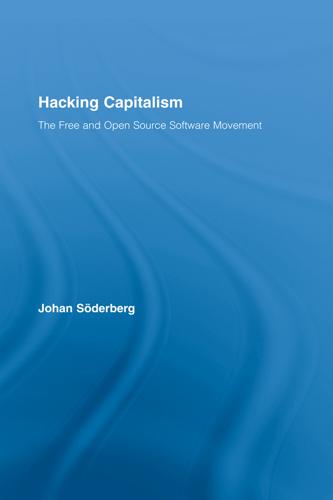
Hacking Capitalism
by
Söderberg, Johan; Söderberg, Johan;
Karl Marx, Economic and Philosophic Manuscripts of 1844 (USSR: Progress Publishers, 1981), 37, italics in original; hereafter cited in text as 1844. 5. Thomas Malone & Robert Laubacher, “The Dawn of the E-Lance Economy” Harvard Business Review (September 1, 1998). 6. ed. Oliver Williamson and Sidney Winter, The Nature of the Firm: Origins, Evolution, and Development (New York: Oxford University Press, 1993). 7. Yochai Benkler, “Coase’s Penguin, or, Linux and The Nature of the Firm”, The Yale Law Journal vol.112 no.3 (December 2002), and The Wealth of Networks—How Social Production Transforms Markets and Freedom, (New Haven: Yale University Press, 2006). 8. Walter Powel, in ed. Barry Staw & Larry Cummings, Research in Organizational Behavior (London: Jai Press, 1990), 303. 9.
…
On the Aesthetic Education of Man—In a Series of Letters/Friedrich Schiller, Oxford: Clarendon Press, 1982. ed. Willcocks, Leslie, and Stephanie Lester. Beyond the IT Productivity Paradox, Chichester: Wiley, 1999. Williams, Raymond. Problems in Materialism and Culture, London: Verso, 1980. ——— Towards 2000, London: Chatto & Windus, 1983. ed. Williamson, Oliver, and Sidney Winter. The Nature of the Firm: Origins, Evolution, and Development: New York: Oxford University Press, 1993. Winner, Langdon. The Whale and the Reactor—A Search for Limits in an Age of High Technology, Chicago: The University of Chicago Press, 1986. Wolf, Naomi. The Beauty Myth—How Images of Beauty Are Used Against Women, London: Vintage, 1991.
…
“The Contestation of Code—A Preliminary Investigation into the Discourse of the Free/Libre and Open Source Movements.” Critical Discourse Studies (April 2004). Bassiouni, Cherif. “Universal Jurisdiction for International Crimes: Historical Perspectives and Contemporary Practice.” Virginia Journal of International Law, vol.42, no.8 (2001). Benkler, Yochai. “Coase’s Penguin, or, Linux and The Nature of the Firm.” The Yale Law Journal, vol.112, no.3, (December 2002). Bettig, Roland. “The Enclosure of Cyberspace.” Critical Studies in Mass Communication 14 (1997). Bowing, Finn. “From the Mass Worker to the Multitude: A Theoretical Contextualisation of Hardt and Negri’s Empire”. Capital & Class 83 (2004).
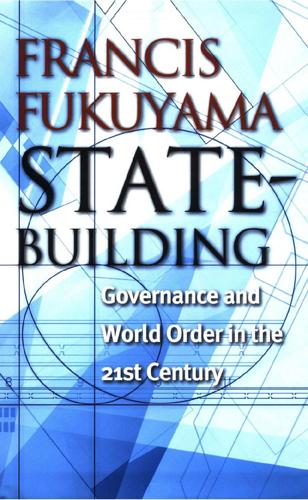
State-Building: Governance and World Order in the 21st Century
by
Francis Fukuyama
Published 7 Apr 2004
Toward a Theory of a Rent-Seeking Society (College Station, TX: Texas A&M Press). Carpenter, Ted Galen. 1997. Delusions of Grandeur: The United Nations and Global Intervention (Washington, DC: CATO Institute). Chandler, Alfred D. 1977. The Visible Hand: The Managerial Revolution in American Business (Cambridge, MA: Harvard University Press). Coase, Ronald H. 1937. “The Nature of the Firm,” Economica 6: 386–405. Cohen, Michael D., and March, James G., et al. 1972. “A Garbage Can Model of Organizational Choice,” Administrative Science Quarterly 17(1): 1–25. Cohen, Theodore. 1987. Remaking Japan: The American Occupation As New Deal (New York: Free Press). Cowhey, Peter F., and Haggard, Stephan. 2001.
…
The Political Economy of Policy Reform (Washington, DC: Institute for International Economics). 132 bibliography Williamson, Oliver E. 1975. Markets and Hierarchies: Analysis and Antitrust Implications (New York: Free Press). ——. 1985. The Economic Institutions of Capitalism (New York: Free Press). ——. 1993. The Nature of the Firm: Origins, Evolution and Development (Oxford, England: Oxford University Press). Williamson, Roger. 1998. Some Corner of a Foreign Field: Intervention and World Order (New York: St. Martin’s Press). Wilson, James Q. 1989. Bureaucracy: What Government Agencies Do and Why They Do It (New York: Basic Books).

The Power of Pull: How Small Moves, Smartly Made, Can Set Big Things in Motion
by
John Hagel Iii
and
John Seely Brown
Published 12 Apr 2010
Second, during the 1950s, another generation of business leaders broadened their horizons to scale push programs beyond national boundaries to take advantage of trade liberalization and to serve global markets. It is no coincidence that the famous British economist Ronald Coase wrote his path-breaking essay, “The Nature of the Firm,” in 1937.4 He effectively captured the primary thrust of institution-building during this period, arguing that firms existed to reduce the transaction costs that made coordinating activity across independent entities difficult. For this insight, he won the Nobel Prize in Economics. As firms deployed these new push-based approaches, other institutions underwent similar transformations.
…
See Heath Row, “Yawn and Guarded,” Fast Company Member Blog, February 8, 2008, http://www.fastcompany.com/blog/heath-row/yawn-and-guarded. 3 See for instance, Alfred D. Chandler Jr., Scale and Scope: The Dynamics of Industrial Capitalism (Cambridge: Harvard University Press, 1994). 4 Ronald Coase, “The Nature of the Firm,” Economica 4, no. 16 (November 1937): 386-405. 5 For more about the role of real-time information in the Saffron Revolution, as well as in other political crises, see Nik Gowing, “‘Skyful of Lies’ and Black Swans: The New Tyranny of Shifting Information Power in Crises,” Reuters Institute for the Study of Journalism, May 2009, http://reutersinstitute.politics.ox.ac.uk/fileadmin/documents/Publications/Skyful_of_Lies.pdf. 6 Ibid. 7 See, for instance, “‘Neda’ Becomes Rallying Cry for Iranian Protests,” CNN, June 22, 2009, http://www.cnn.com/2009/WORLD/meast/06/21/iran.woman.twitter/index.html?
…
Microsoft as example of shaping view motivates third-party investments Mindsets for management of collaboration of control, threatened by change Minnick, Mary Mirabilis Mobile phone industry Modular design of pull platforms described Li & Fung’s specific activities, outputs motivates passionate individuals to success Moore’s Law Mor ville, Peter Motorola Mousavi, Mir-Hossein Myanmar (Burma) Saffron Revolution National Scholastic Surfing Association “The Nature of the Firm” essay (Coase) NetWeaver Networks types of, described Newspapers 9/11 attacks Noll, Greg Nonprofit organizations experiencing performance pressures shaping strategies in Novell Oahu, Hawaii Obama, Barack Obstfeld, David The Office television program Old-boy networks Online communities.

Here Comes Everybody: The Power of Organizing Without Organizations
by
Clay Shirky
Published 28 Feb 2008
This ability of the traditional management structure to simplify coordination helps answer one of the most famous questions in all of economics: If markets are such a good idea, why do we have organizations at all? Why can’t all exchanges of value happen in the market? This question originally was posed by Ronald Coase in 1937 in his famous paper “The Nature of the Firm,” wherein he also offered the first coherent explanation of the value of hierarchical organization. Coase realized that workers could simply contract with one another, selling their labor, and buying the labor of others in turn, in a market, without needing any managerial oversight. However, a completely open market for labor, reasoned Coase, would underperform labor in firms because of the transaction costs, and in particular the costs of discovering the options and making and enforcing agreements among the participating parties.
…
At the extremes they are forced to adopt both strategies, to limit both the number and the depth of interactions. A wedding reception is a localized version of this trade-off. The bride and groom gather a room full of people they could talk to for hours, then talk to most of the guests for just a few minutes each so as not to be rude. Why Would Anyone Bother? Coase’s logic in “The Nature of the Firm” suggests that in organizing any group, the choice is between management and chaos; he assumes that it’s very difficult to create an unmanaged but nonchaotic group. But lack of managerial direction makes it easier for the casual contributor to add something of value; in economic terms, an open social system like Wikipedia dramatically reduces both managerial overhead and disincentives to participation.
…
Though this book is filled with interesting general observations about the design of software, the observation that adding more programmers to a late project makes it later is by far Brooks’s most famous observation, and the one with the broadest applicability beyond the world of software engineering. Page 30: “The Nature of the Firm,” R. H. Coase, Economica 4(16), November 1937, pp. 386-405, also at www.cerna.ensmp.fr/Enseignement/CoursEcoIndus/SupportsdeCours/COASE.pdf. This short work comes from an era when economics papers were readable, and the clarity and elegance of the argument makes the paper relevant even today.

Reinventing Discovery: The New Era of Networked Science
by
Michael Nielsen
Published 2 Oct 2011
Its only drawback is that it’s becoming a little dated (2004), but there is much in the book that is relatively timeless. Going even further back, there is Eric Raymond’s famous essay “The Cathedral and the Bazaar” [178]. Raymond’s essay is what first got me (and many others) interested in open source, and it remains well worth reading. Yochai Benkler’s insightful “Coase’s Penguin, or, Linux and The Nature of the Firm” [12] and The Wealth of Networks [13] have strongly influenced much thinking about open source, especially in the academic community. Finally, I recommend Ned Gulley and Karim Lakhani’s fascinating account [87] of the Mathworks programming competition. Limits to collective intelligence: Informative summaries are Cass Sunstein’s Infotopia [212] and James Surowiecki’s The Wisdom of Crowds [214].
…
p 38: The “dumb question” was posed by Polymath participant Ryan O’Donnell: [159]. p 39: On the point that online tools are subsuming and extending both conventional markets and conventional organizations: a related point has been made by the theorist Yochai Benkler in his article “Coase’s Penguin, or, Linux and The Nature of the Firm [12].” Benkler has a different focus, being concerned not so much with the solution of creative problems as with the production of goods. He proposes that online collaboration has enabled a third form of production, beyond markets and conventional organizations, which he calls “peer production.”
…
Monthly Notices of the Royal Astronomical Society, 406(1):342–353, July 2010. eprint arXiv:0908.2033. [11] J. Battelle. The Search: How Google and Its Rivals Rewrote the Rules of Business and Transformed Our Culture. Boston: Nicholas Brealey, 2005. [12] Yochai Benkler. Coase’s penguin, or, Linux and The Nature of the Firm. The Yale Law Journal, 112:369–446, 2002. [13] Yochai Benkler. The Wealth of Networks. New Haven: Yale University Press, 2006. [14] Tim Berners-Lee. Weaving the Web. New York: Harper Business, 2000. [15] Tim Berners-Lee and James Hendler. Publishing on the semantic web. Nature, 410:1023–1024, April 26, 2001
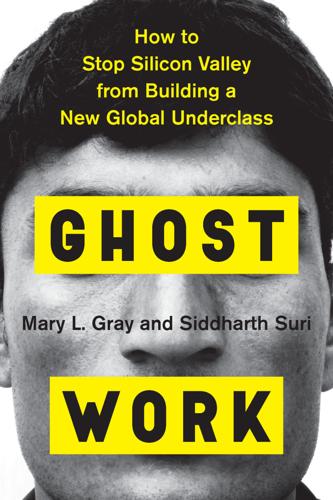
Ghost Work: How to Stop Silicon Valley From Building a New Global Underclass
by
Mary L. Gray
and
Siddharth Suri
Published 6 May 2019
Transaction costs are those expenses associated with managing the production and exchange of goods or services. Nobel laureate Ronald Coase, a key contributor to modern economic theory, popularized the notion of transaction costs, though he did not coin the phrase itself. His seminal 1937 article “The Nature of the Firm” was published only two years after Wagner passed the National Labor Relations Act. In it, Coase argued that businesses had to coordinate their operations, such as finding, hiring, and training workers, to reduce market frictions. The only route to lower costs and to turning a profit hinged on making businesses run as smoothly as possible.
…
“More than Money: Correlation Among Worker Demographics, Motivations, and Participation in Online Labor Markets.” Under review, ICWSM ’19: The 13th International AAAI Conference on Web and Social Media, Munich, Germany, June 2019. Clawson, Dan, and Naomi Gerstel. Unequal Time: Gender, Class, and Family in Employment Schedules. New York: Russell Sage Foundation, 2014. Coase, R. H. “The Nature of the Firm.” Economica 4, no. 16 (1937): 386–405. https://doi.org/10.1111/j.1468-0335.1937.tb00002.x. Coca, Nithin. “Nurses Join Forces with Labor Union to Launch Healthcare Platform Cooperative.” Shareable. Accessed June 21, 2018. https://www.shareable.net/blog/nurses-join-forces-with-labor-union-to-launch-healthcare-platform-cooperative.
…
Our intent is not to downplay the emotional distress of seeing a deceased child’s face pop up in a Facebook app meant to showcase the past year’s highlights. Lee Humphreys also discusses Facebook’s algorithmic curation of memory within her theory of media accounting. See Lee Humphreys, The Qualified Self: Social Media and the Accounting of Everyday Life (Cambridge, MA: MIT Press, 2018), 85–90. [back] 3. R. H. Coase, “The Nature of the Firm,” Economica 4, no. 16 (1937): 388, https://doi.org/10.1111/j.1468-0335.1937.tb00002.x. [back] 4. Mason and Suri, “Amazon’s Mechanical Turk,” 1–23. [back] 5. For generative, pivotal critiques of this framing, see Ilana Gershon, Down and Out in the New Economy: How People Find (or Don’t Find) Work Today (Chicago: University of Chicago Press, 2017); Melissa Gregg, Work’s Intimacy (Cambridge, England: Polity, 2011); Melissa Gregg, Counterproductive: Time Management in the Knowledge Economy (Durham, NC: Duke University Press, 2018); Gina Neff, Venture Labor: Work and the Burden of Risk in Innovative Industries (Cambridge, MA: MIT Press, 2012); Trebor Scholz, Uberworked and Underpaid: How Workers Are Disrupting the Digital Economy (Cambridge, England: Polity, 2016).

Company: A Short History of a Revolutionary Idea
by
John Micklethwait
and
Adrian Wooldridge
Published 4 Mar 2003
The much-vaunted idea that companies are now bigger than mere governments is, as we shall see, statistically fraudulent. Big companies are giving way to small ones, so much so, in fact, that an old question is now more pressing: What is the point of companies? That question was most succinctly answered back in 1937 by Ronald Coase, a young British economist. In an article called “The Nature of the Firm,” he argued that the main reason why a company exists (as opposed to individual buyers and sellers making ad hoc deals at every stage of production) is because it minimizes the transaction costs of coordinating a particular economic activity. Bring all the people in-house, and you reduce the costs of “negotiating and concluding a separate contract for each exchange transaction.”
…
Whom were they run for? And what about the workers? The most basic of these three works began as a lecture in 1932 to a group of Dundee students by a twenty-one-year-old economist just back from a tour of American industry. Five years later, Ronald Coase published his ideas in a paper in Economica called “The Nature of the Firm.” Coase tried to explain why the economy had moved beyond individuals selling goods and services to each other. The answer, he argued, had to do with the imperfections of the market and particularly to do with transaction costs—the costs sole traders might incur in getting the best deal and coordinating processes such as manufacturing and marketing.
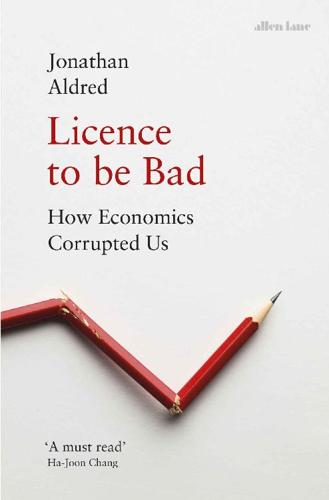
Licence to be Bad
by
Jonathan Aldred
Published 5 Jun 2019
So, as he put it, ‘I switched to the only other degree for which it was possible to study at the Kilburn Grammar School, one in commerce.’4 By this accidental route, Coase ended up studying economics at the London School of Economics in 1929. He learned fast. The ideas for his first academic paper were already written up in a lecture he gave in Dundee three years later, aged twenty-one, and this first paper, ‘The Nature of the Firm’, was special: it was one of the two great contributions to economics that would lead to his Nobel Prize for economics over half a century later. (In a nutshell, ‘The Nature of the Firm’ tries to explain why firms exist at all: why, in particular, entrepreneurs choose to hire workers on an ongoing basis rather than ‘contracting out’ each and every task.) But it’s his other contribution, ‘The Problem of Social Cost’, that we’re concerned with here.
…
air travel, commercial, 63–4 Akerlof, George, 223, 237, 248 altruism, 150–51, 159, 162–4 game theory’s denial of, 31–2, 41, 42–3 misunderstanding of, 13–14, 25, 31–2, 41–3, 112, 178–9 as not depleted through use, 14 seen as disguised selfishness, 11–12, 25, 112, 178–9 Amazon, 155, 178, 208 American Economic Association, 257, 258 Angrist, Joshua, 249 antitrust regulation, 56–8 Apple, 222–3 Aristotle, 14 Arrow, Ken awarded Nobel Prize, 71 and blood donations, 14, 163 at City College, New York, 74–5, 91 collective preference, 73–4, 75–7, 78–82 and democracy, 72–4, 75–7, 78–83, 95, 97 framework presented as scientific, 81–2, 124–5 and free marketeers, 78–9, 82 Impossibility Theorem, 72, 73–4, 75–7, 78–83, 89, 97 and mathematics, 71, 72, 73–5, 76–7, 82–3, 97 and Mont Pèlerin Society, 9 preference satisfaction’, 80–82, 97, 124–5, 129 and Ramsey, 189 at RAND, 70–71, 72–3, 74, 75–6, 77, 78 top-secret-level security clearance, 71–2 ‘A Cautious Case for Socialism’ (1978), 83 ‘On the Optimal Use of Winds for Flight Planning’, 71 Social Choice and Individual Values (1951), 71, 72, 75–7, 78–80, 97 artificial intelligence, 214, 242 Atlas Economic Research Foundation, 7–8 Austen, Jane, 134 austerity policies, recent, 258 Axelrod, Robert, 41 Babbage, Charles, 222 baby-market idea, 61, 138, 145, 146 Bachelier, Louis, 193 Baird, Douglas, 58–9 bandwagon effect, 110 Bank of England, 96, 120, 185, 211–12, 258 bankers excuse/permission to be greedy, 1–2, 204, 238 and Keynesian economics, 5 performance as wholly relative, 204 quantification and recklessness, 213 rigged pay-for-performance contracts, 229–30, 238 role in 2007 crisis, 1–2, 57, 182, 192 as serial offenders over uncertainty, 201 see also financial markets Barro, Josh, 63, 64 Bateson, Gregory, 28 battery-chicken farming, 7 Baumol, William, 90–92, 93, 94 BBC, 48, 98 Beaverbrook, Lord, 157 Becker, Gary amoral understanding of crime, 137, 152 and citizenship rights, 146 and Coase, 69 Freakonomics followers of, 130, 134, 148–9, 156 and Friedman, 126, 131 hidden assumptions of, 130–31, 133–4 human capital idea, 149 and individualism, 134, 135–8 and maximization, 129–31, 133–4, 147 as outsider, 50 and Posner, 56 rejects need for realistic assumptions, 132, 133–4, 148 and sale of body parts, 147–8 sees poor health as just a preference, 135, 136, 140 sees values as mere tastes, 136–8, 140 theories as deeply controversial, 127–9, 130 theories as slippery, 129, 133–4 and ‘universality’ of economics, 125, 126–31, 133–4, 135–8, 147–8 version of ‘rational’ behaviour, 128–9, 135, 140, 151 De Gustibus Non Est Disputandum (with Stigler, 1977), 135–6 The Economic Approach to Human Behavior (1976), 130 The Economics of Discrimination (1957), 126–7 A Treatise on the Family (1981), 127–8, 130–31, 133 behaviourism, 154–8, 237 behavioural economics context and culture, 175–6 framing effects, 170–71, 259 and incentives, 160, 171, 175, 176–7 methods from psychology, 170–71 and Nudge, 171–2 and orthodox economics, 173, 174–5, 247, 255 and physics envy, 175–6 problems with, 173–5, 250–51 ‘self-command’ strategies, 140 theory of irrationality, 12, 171, 250–51 and welfare maximization, 149 Bell, Alexander Graham, 222 bell curve distribution, 191–4, 195, 196, 201, 203–4, 218–19, 257 Bentham, Jeremy, 102 Berlin, Isiah, 166, 167–8 Beveridge Report (1942), 4 Bezos, Jeff, 208 Black, Duncan, 77–8, 95 Blackstone (private equity firm), 235 black swans, 192, 194, 201, 203–4 Blinder, Alan, The Economics of Brushing Teeth (1974), 136 blood donors, 14, 112, 162–3, 164, 169, 176 Borel, Émile, 185* Brennan, William, 56 broadcasting, 48–50, 98 spectrum auctions, 39–40, 47, 49–50 Buchanan, James McGill, 8, 83–5, 87–8, 89, 95, 115 Buffett, Warren, 229, 230, 236 Calcraft, John, 120, 121 Cameron, David, 172 Caplan, Brian, The Myth of the Rational Voter, 245–6 carbon markets, 47, 65–7 Carlson, Jack, 141–2 Carroll, Lewis (Charles Lutwidge Dodgson), 72, 77 cartels and monopolies, 101, 102, 103–4 Cheney, Dick, 232–3 Chicago, University of, 2, 4, 34, 40, 49–51 antitrust ideas, 56–8 Buchanan at, 84 and Coase, 49–52, 53–4, 55, 56–7, 61, 68–9, 132 Friedman’s dominance, 50, 132 law and economics movement, 40, 55, 56–63, 64–7 revolution of 1968 at, 56, 58–9 zero-transaction-costs assumption, 51–2, 68–9 Chicago law school, 55, 56, 58–9 child labour, 124, 146 China, 65 City College, New York, 74–5, 91 climate change average temperature rises, 205–6, 207 and carbon markets, 47, 65–6 ‘cashing in’ on carbon markets, 67 Coasean worldview on pollution, 65–7, 68 denialists, 8 ‘discount rate’ on future costs, 208–9, 212 discrimination against future generations, 208–9 and free-riding theory, 2, 99, 113–17, 120 Intergovernmental Panel on, 207 measurement in numerical terms, 206–11, 213 and precautionary principle, 211–12 premature deaths due to, 207–9 and Prisoner’s Dilemma, 27 Stern Review, 206, 209–10 threat to economic growth, 209 Coase, Ronald argument given status of theorem, 51–2, 67 awarded Nobel Prize, 52 background of, 47–8 and Chicago School, 49–52, 53–4, 56–7, 61, 68–9, 132 and created markets, 47, 65–7 dismissal of ‘blackboard economics’, 48, 54, 64, 67–9 on Duncan Black, 77 evening at Director’s house (early 1960), 49–51, 132 fundamental misunderstanding of work of, 51, 52–3, 67–9 hypothetical world invoked by, 50–51, 52, 54–5, 62, 68 as Illinois resident, 46–7 and Mont Pèlerin Society, 8 and public-sector monopolies, 48–51 and transaction costs, 51–3, 54–5, 61, 62, 63–4, 68 ‘The Nature of the Firm’ (1932 paper), 48 The Problem of Social Cost’ (1960 paper), 47, 48, 50–51, 52, 54–5, 59 cognitive dissonance, 113–14 Cold War, 18–19, 20, 21–2, 24, 27, 181 Cuban Missile Crisis (1962), 33–4, 140 and Ellsberg, 184, 197, 198, 200 and game theory, 18, 20, 21–2, 24, 27, 33–4, 35, 70, 73, 198 and Impossibility Theorem, 75–6 RAND and military strategy, 18, 20, 21–2, 24, 27, 33–4, 70, 73, 75–6, 141, 200, 213 and Russell’s Chicken, 33 and Schelling, 138, 139–40 Washington–Moscow hotline installed, 139–40 collective preference and Ken Arrow, 73–4, 75–7, 78–82 Black’s median voter theorem, 77, 95–6 Sen’s mathematical framework, 80–81 communism, 82, 84, 101, 104, 237 Compass Lexecon, 58, 68 Condorcet Paradox, 76, 77 conspiracy theories, 3, 8, 9 cooperation cartels, monopolies, price-fixing, 101, 102, 103–4 and decision-making processes, 108–10 and free-riding theory, 2, 101, 102, 103–10 office teamwork, 109–10, 112 older perspective on, 100–102, 108, 111, 122 and Scandinavian countries, 103 view of in game theory, 21–2, 23, 25–32, 36–8, 41–3 corporate culture and antitrust regulation, 57–8 changes due to Friedman, 2, 152 Chicago approach to regulation, 40 and climate change, 113, 114, 115 executive pay, 215–16, 219, 224, 228–30, 234, 238 Jensen and Murphy’s article, 229 ‘optimal contracting’/pay-for-performance, 228–30, 238 predatory pricing, 57 and tax evasion/avoidance, 105–6 cost disease, 90–92, 93, 94 Cowles Commission in Chicago, 78 CP/M (Control Program for Microcomputers), 222 criminal responsibility, 111, 137, 152 Cuban Missile Crisis (1962), 33–4, 140 Damasio, Antonio, 14 data geeks, 248–50 ‘dead peasants insurance’, 124 decision-making processes, 108–10, 122, 170–71 ‘anchoring effect’, 212 authority figure–autonomy contradiction, 180 avoidance of pure uncertainty, 198–9 axioms (abstract mathematical assumptions), 198 Ellsberg Paradox, 184, 199–200 Ellsberg’s experiment (1961), 182–4, 187, 197, 198–200, 205 Linda Problem, 202–3 orthodox decision theory, 183–4, 185–6, 189–91, 193–4, 198–200, 201–2, 203–5, 211, 212–14 and the Savage orthodoxy, 190–91, 197, 198–200, 203 scenario planning as crucial, 251 Von Neumann’s theory of decision-making, 189, 190, 203 see also probability; risk and uncertainty democracy and Ken Arrow, 72–4, 75–7, 78–83, 95, 97 Black’s median voter theorem, 77, 95–6 and crises of the 1970s, 85–6 and economic imperialism, 145–7 equal citizenship principle at heart of, 145–6, 151 free-riding view of voting, 99, 110, 112, 115–16, 120–21 marketing by political parties, 95–6 modern cynicism about politics, 94–7 paradox of voter turnout, 88–9, 95–6, 115–16 paradox of voting, 75–7 politicians’ support for depoliticization, 96–7 post-war scepticism about, 78–9 and public choice theory, 85–6, 95–7 replacing of with markets, 79 Sen’s mathematical framework, 80–81 voter turnout, 88–9, 95–6, 115–16, 120–21 see also voting systems Dennison, Stanley, 13 dentistry, 258–9, 261 Depression (1930s), 3 digital technology, 68, 214, 222–3 data revolution, 247–50 and rising inequality, 215, 220, 242 Director, Aaron, 4–5, 49–51, 132 Disney World, 123 Dodd–Frank Act, 256 Dodgson, Charles Lutwidge (Lewis Carroll), 72, 77 dot.com bubble, 192, 201 Douglas Aircraft Corporation, 18 Downs, Anthony, An Economic Theory of Democracy (1957), 86, 89, 95 Dr Strangelove (Kubrick film, 1964), 19, 35, 139 DreamTours Florida, 123 Drucker, Peter, 153 Dulles, John Foster, 20 Dundee School of Economics, 48, 77–8 Dürrenmatt, Friedrich, The Visit of the Old Lady, 166 earthquakes, 194–5 Econometrica (journal), 77–8 economic imperialism arrogance of, 246–7 auctioning of university places, 124, 149–50 continuing damage wrought by, 151–2 and democracy, 145–7 emerges into the limelight, 130 Freakonomics, followers of, 130, 134, 148–9, 156 and inequality, 145–7, 148, 151, 207 markets in citizenship duties, 146 origins of term, 125 price as measure of value, 149, 150, 151 purchase of immigration rights, 125, 146 and sale of body parts, 123, 124, 145, 147–8 sidelining of moral questions, 125–9, 135–8, 141–5, 146–7, 148–9, 151–2, 207 value of human life (‘statistical lives’), 141–5, 207 welfare maximization, 124–5, 129–31, 133–4, 146–7, 148–9 see also Becker, Gary economic theory Arrow establishes benchmark for, 71 Baumol’s cost disease, 90–92, 93, 94 Coase Theorem, 45–7, 48–55, 56–7, 61, 63–6 and data revolution, 247–50 exclusion of by data geeks, 248–50 and financial markets, 9, 12–13, 182, 253 as focus of economics courses, 260 Kahneman and Tversky’s theory of irrationality, 12, 171, 250–51 of labour, 237 marginal productivity theory, 223–4, 228 Pareto efficiency, 217–18, 256* perfect competition, 103, 193–4 profit-maximizing firms, 228–9 rent-seeking, 230, 238 theory of motivation, 157–8, 164, 166–7, 168–70, 178–9 see also game theory; homo economicus; public choice theory; social choice theory economics accidental economists, 47–8 and Arrow’s framework, 78–9, 82 causes of growth, 223, 239 created markets, 47, 65–7 crises of the 1970s, 85–6 digital technology, 68, 214 efficiency as fundamental, 63, 64–5, 141, 153, 155, 193–4, 201, 211, 217–18, 255 empirical research as still rare, 247–8 extension into non-economic aspects of life, 40, 54–60, 65, 123–31, 132–4, 135–6, 145–50 gulf between reality and theory, 10–13, 31–2, 41–3, 51–3, 64–9, 86–9, 133, 136, 144–5, 228–30, 250–53, 260–61 history of, 260 lack of objective ‘facts’, 253 modern debate on, 9 and Olson’s analysis, 104 our love–hate relationship with, 3, 245 as partially self-fulfilling, 12–13, 14, 159, 253 percentage of GDP impact of climate change, 206–11, 213 positional goods, 239–41 Posner’s wealth-maximization principle, 57–63, 64–7, 137 predatory pricing, 57 principles for new relationship with, 251–61 privatization, 50, 54, 88, 93–4 rise of game theory, 40–41 Smith’s enlightened self-interest, 11 value of human life (‘statistical lives’), 141–5, 207 vocational role of, 260 see also behavioural economics; free-market economics economics, aims/pretensions to be science arrogance of, 205, 245–7, 258 Arrow’s framework presented as scientific, 72, 81–2, 124–5 attitude to value judgements, 10, 60–61, 64–9, 112, 136–8, 173–4, 204–5, 218, 247 claims of game theory, 21, 24–6, 28–9, 32, 34, 35, 38, 41 and data revolution, 247–50 desire for neutral science akin to physics, 9–10, 20–21, 34–5, 41, 116, 125, 132–3, 151, 175–6, 187–90, 212, 217–18, 246–56 desire for science of social control, 153, 154, 155, 164, 167 Friedman’s ‘The Methodology of Positive Economics’, 132–3 hidden political/ethical agendas, 10, 213, 253, 255–8 measurement of risk in numerical terms, 181–4, 187, 189, 190–94, 196–7, 201–2, 203–5, 212–13 natural experiments, 248–50 Pareto improvements, 217–18 and physics envy, 9, 20–21, 41, 116, 175–6, 212, 247 and public choice theorists, 88 quantification of all risks and values, 201–2, 203, 212–13 real world as problem for, 10–13, 31–2, 42–3, 51–3, 64–9, 86–9, 133, 136, 144–5, 228–30, 250–53, 260–61 ‘some number is better than no number’ mantra, 212–13 uncertainty as obstacle to, 190–91, 212–13 and use of mathematics, 9–10, 26, 72, 247, 248, 255, 259 use of term ‘rational’, 12 Von Neumann and Morgenstern’s grand project, 20–21, 24–5, 26, 35, 125, 151, 189 and wealth-maximization approach, 58, 60 economists advice to former Soviet Bloc nations, 257 conflicts of interest, 256–7, 258 data geeks, 248–50 economics curriculum reform needed, 259–60 errors and misjudgements, 13–14, 16, 132–3, 144–5, 256*, 257–8, 260–61 failure to explain ideas, 254–5 insularity of, 246–7 Keynes’ dentistry comparison, 258–9, 261 lack of ethics codes, 257–8 misunderstanding of altruism, 13–14, 25, 31–2, 41–3, 112, 178–9 need to show more humility, 258–9, 260–61 as not separate from economy, 251–3 and ordinary people, 245–6, 254–5, 258, 261 self-image as unsentimental and honest, 10 sneering descriptions of virtuous behaviour, 112 stating of the obvious by, 134, 259 education auctioning of university places, 124, 149–50 Baumol’s cost disease, 91, 92, 93, 94 incentivization as pervasive, 156, 169 value of, 150, 169, 170 ‘efficient market hypothesis’, 193–4, 201, 255 Einstein, Albert, 17, 22, 33, 213 Eisenhower, Dwight D., 19, 20, 231 Ellsberg, Daniel, 182–4, 187, 197–8 Ellsberg Paradox, 184, 199–200 and the ‘Pentagon Papers’, 200 probability experiment (1961), 182–4, 187, 197, 198–200 ‘Risk, Ambiguity and the Savage Axioms’ (paper, 1961), 198–9, 200 Engelbart, Douglas, 222–3 Engels, Friedrich, 223 English, Bill, 222–3 Enlightenment thinking, 11, 185 Epstein, Richard, 127 ethics and morality and autonomy, 164, 165–6, 168, 169–70, 180 bad behaviour redefined as rational, 12 and blame for accidents, 55, 60–61 and Coase Theorem, 46–7, 54–5, 56–7, 61, 63–6 Coasean worldview on pollution, 66–7, 68 as conditioned and limited by economics, 3, 10, 15, 43, 55, 60–61, 64–5, 179, 204–5, 218, 247 cooperative behaviour in game theory, 29, 30–32 core principles of current economic orthodoxy, 253 distinction between values and tastes, 136–8 economists’ language on virtuous behaviour, 112 inequality as moral issue, 242–3 influence of recent economic ideas, 1–3, 15–16 Keynes on economics as moral science, 252–3 law and economics movement, 40, 55, 56–63, 64–7 moral disengagement, 162, 163, 164, 166 morally wrong/corrupting incentives, 168–9 and Nash program, 25 Nudge economists, 173–4, 251 Posner’s wealth-maximization principle, 57–63, 64–7, 137 Puzzle of the Harmless Torturers, 118–19 Ramsey Rule on discounting, 208–9, 212 sale of body parts, 123, 124, 145, 147–8 sidelined by economic imperialism, 125–9, 135–8, 141–5, 146–7, 148–9, 151–2, 207 small contributions as important, 110, 114–15, 122 Smith’s enlightened self-interest, 11 value of human life (‘statistical lives’), 141–5, 207 see also altruism; free-riding behaviour European Commission, 96 Facebook UK, 99 fairness, 1, 149, 218, 228, 253 and Coase, 54, 55 and free-riding behaviour, 107 and game theory, 43 and incentives, 177, 179 and lucky geniuses, 221–3 and Posner’s wealth-maximization principle, 60, 61, 62 see also inequality family life, 127–8, 130–31, 133, 156 famine relief, 99, 114–15 Farmer, Roger, 259 Federal Communications Commission (FCC), 48–9 Ferdinand, Archduke Franz, 185 financial crisis, global (2007–10) Becker on, 128–9 and bell curve thinking, 192, 193–4, 196, 257 ‘blame the regulators’ argument, 1–2 and financial economists, 9, 88, 260–61 persuasive power of extreme numbers, 181–2 and Posner’s wealth-maximization principle, 57 underlying maths of, 194, 195–6 financial markets Bachelier’s theory of speculation, 193 bell curve thinking, 192, 193–4, 195, 196–7, 201, 203–4, 257 benchmarking against the market, 204 Black Monday (1987), 192 deregulation of US banks, 194 derivatives, 253 dot.com bubble, 192, 201 East Asian crisis (1997), 192 and economic theory, 9, 12–13, 182, 253 economists’ ignorance of, 260–61 and First World War, 185 and fractals (scale-invariance), 194, 195–6, 201 orthodox decision theory, 190–91, 193–4, 201 persuasive power of extreme numbers, 181–2, 191, 192 and rent-seekers, 230, 238 rigged pay-for-performance contracts, 229–30, 238 First World War, 185, 210, 211–12 Fisher, Antony, 6–8 Forster, E.
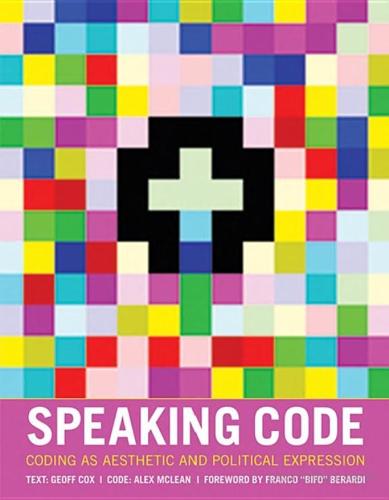
Speaking Code: Coding as Aesthetic and Political Expression
by
Geoff Cox
and
Alex McLean
Published 9 Nov 2012
James Leach, “Modes of Creativity and the Register of Ownership,” in Ghosh, Code. 39. Ibid., 33–34. 40. Ibid., 35. 41. GNU General Public License; available at http://www.gnu.org/copyleft/gpl.html. 42. Leach, “Modes of Creativity and the Register of Ownership,” 41. 43. Yochai Benkler, “Coase’s Penguin, or, Linux and the Nature of the Firm,” in Ghosh, Code, 169. He is referring to the economist Ronald Coase’s essay “The Nature of the Firm,” of 1937. 44. Michel Bauwens, “The Social Web and Its Social Contracts: Some Notes on Social Antagonism in Netarchical Capitalism,” Re-Public (2008; available at http://www.re-public.gr/en/?p=261). 45. Ibid. 46. Ibid. 47. Virno, A Grammar of the Multitude, 110. 48.
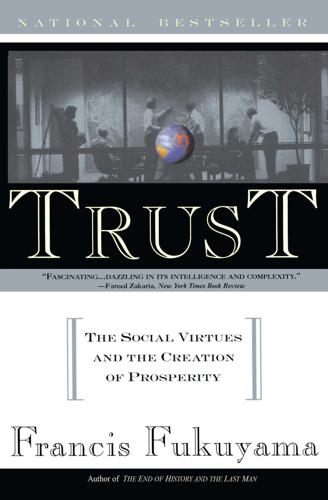
Trust: The Social Virtue and the Creation of Prosperity
by
Francis Fukuyama
Published 1 Jan 1995
Whitley, “East Asian Enterprise Structures and the Comparative Analysis of Forms of Business Organization,” Organization Studies 11 (1990): 47-74. 10For an account, see Masaru Yoshimori, “Source of Japanese Competitiveness, Part I,” Management Japan 25 (1992): 18-23. 11Ronald H. Coase, “The Nature of the Firm,” Economica 4 (1937): 386-405. 12See inter alia Oliver E. Williamson, “The Economics of Organization: The Transaction Cost Approach,” American Journal of Sociology 87 (1981, hereafter 1981a): 548-577; The Nature of the Firm: Origins, Evolution, and Development (Oxford: Oxford University Press, 1993); and “The Vertical Integration of Production: Market Failure Considerations,” American Economic Review 61 (1971): 112-123. 13Oliver Williamson, “The Modern Corporation: Origins, Evolution, Attributes,” Journal of Economic Literature 19 (1981, hereafter 1981b): 1537-1568. 14According to Williamson, “The human agents that populate the firms and markets with which I am concerned differ from economic man (or at least the common caricature thereof) in that they are less competent in calculation and less trustworthy and reliable in action.
…
Cherrington, David J., The Work Ethic: Working Values and Values that Work (New York: Amacom, 1980). Clegg, Stewart R. and Redding, S. Gordon, Capitalism in Contrasting Cultures (Berlin: Walter de Gruyter, 1990). Clifford, Mark L., Troubled Tiger: Businessmen, Bureaucrats and Generals in South Korea (Armonk, N.Y.: M. E. Sharpe, 1994). Coase, Ronald H., “The Nature of the Firm,” Economica 6 (1937): 386-405. Cohen, Daniel, “The Fall of the House of Wang,” Business Month 135 (1990): 22-31. Coleman, James S., “Social Capital in the Creation of Human Capital,” American Journal of Sociology, 94 Supplement (1988): S95-S120. Congleton, Roger D., “The Economic Role of a Work Ethic,” Journal of Economic Behavior and Organization 15 (1991): 365-385.
…
Williamson, Oliver E., Corporate Control and Business Behavior (Englewood Cliffs, N.J.: Prentice-Hall, 1970). -----, Oliver E., “The Economics of Organization: The Transaction Cost Approach,” American Journal of Sociology 87 (1981): 548-577. -----, “The Modern Corporation: Origins, Evolution, Attributes,” Journal of Economic Literature 19 (1981): 1537-156. -----, The Nature of the Firm: Origins, Evolution and Development (Oxford: Oxford University Press, 1993). -----, “The Vertical Integration of Production: Market Failure Considerations,” American Economic Review 61 (1971): 112-123. Wilson, James Q., “The Family-Values Debate,” Commentary 95 (1992): 24-31. -----, The Moral Sense (New York: Free Press, 1993). -----, Negro Politics: the Search for Leadership (Glencoe, Ill.: Free Press, 1960).
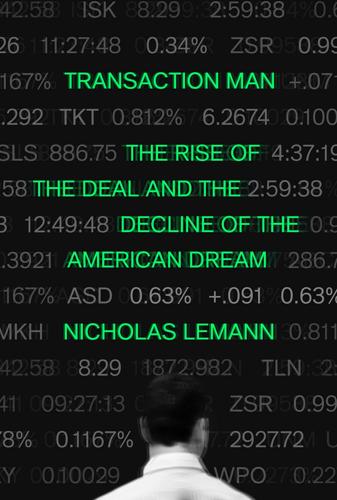
Transaction Man: The Rise of the Deal and the Decline of the American Dream
by
Nicholas Lemann
Published 9 Sep 2019
The financial economists had laid waste to the traditional ways of thinking about the financial mechanisms associated with the almighty corporation—stocks and bonds—but what about the corporation itself? Shouldn’t it be subject to the same kind of devastatingly rigorous and unsentimental analysis? An early crack in the intellectual edifice around the corporation appeared way back in 1937, in the form of an article called “The Nature of the Firm,” by Ronald Coase, a twenty-six-year-old British economist who joined the University of Chicago faculty not long after Michael Jensen had arrived there as a graduate student, and who later won the Nobel Prize. “Why is there any organization?” in business, Coase asked. Why not just let the unimpeded market, rather than corporate managers, decide where to build plants, when to launch products, and where to direct workers?
…
It implied, unsurprisingly, that the Economic Graph the company had been promoting was the key to growth: whether or not it was a direct case of cause and effect, cities with denser networks of LinkedIn connections produced more new jobs than cities with sparser networks. The perpetually exuberant intellectual culture of Silicon Valley had rediscovered Ronald Coase’s old essay “The Nature of the Firm”; the current read of it was that the Internet had reduced transaction costs so radically that conventional business organizations were becoming unnecessary (which of course meant that conventional benefits and pensions would be unnecessary too). Even the most complex projects could be executed by loose, temporary assemblages of talent.
…
“Major corporations in most instances”: Adolf Berle, The Twentieth Century Capitalist Revolution, Harcourt, Brace and Company, 1954, 40. “the visible hand of management”: Alfred D. Chandler, The Visible Hand: The Managerial Revolution in American Business, Belknap Press, 1977, 1. “Why is there any organization?”: Ronald H. Coase, “The Nature of the Firm,” Economica, Volume 4, Number 16 (November 1937), 388. “folklore”: Henry Manne, “The ‘Higher Criticism’ of the Modern Corporation,” Columbia Law Review, Volume 62, Number 3 (March 1962), 407. “losing the only objective standard”: Manne, “‘Higher Criticism,’” 415. “represent disguised efforts”: Manne, “‘Higher Criticism,’” 431.
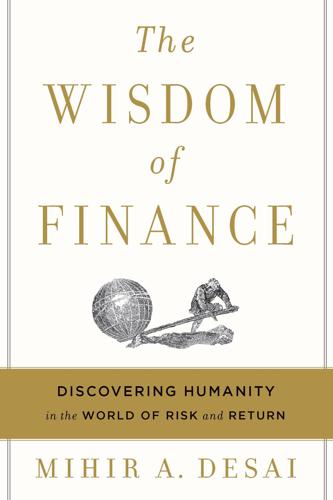
The Wisdom of Finance: Discovering Humanity in the World of Risk and Return
by
Mihir Desai
Published 22 May 2017
Journal of Law and Economics 21, no. 2 (1978): 297–326; Klein, Benjamin. “Vertical Integration as Organizational Ownership: The Fisher Body–General Motors Relationship Revisited.” Journal of Law, Economics and Organization 4, no. 1 (March/April 1998): 199–213; Klein, Benjamin. “Fisher–General Motors and the Nature of the Firm.” Journal of Law and Economics 43, no. 1 (2000): 105–42; Freeland, Robert F. “Creating Holdup Through Vertical Integration: Fisher Body Revisited.” Journal of Law and Economics 43, no. 1 (2000): 33–66; Coase, R. H. “The Acquisition of Fisher Body by General Motors.” Journal of Law and Economics 43, no. 1 (2000): 15–32; and Casadesus-Masanell, Ramon, and Daniel F.
…
Spulber. “The Fable of Fisher Body” Journal of Law and Economics 43, no. 1 (2000): 67–104; and Sloan, Alfred P. My Years with General Motors. Garden City, NY: Doubleday, 1964. The less romantic interpretation of the GM–Fisher Body story is a version of the work pioneered in Coase, Ronald H. “The Nature of the Firm.” Economica 4, no. 16 (1937): 386–405. The more romantic version of the story is a version of the work summarized in Hart, Oliver D. Firms, Contracts, and Financial Structure. Oxford: Clarendon Press, 1995. A middle ground of sorts is provided by Williamson, Oliver E. Markets and Hierarchies: Analysis and Antitrust Implications: A Study in the Economics of Internal Organization.

Whiplash: How to Survive Our Faster Future
by
Joi Ito
and
Jeff Howe
Published 6 Dec 2016
The first, obviously, is the development of the Internet, which unlike any previous communication technology provided connections from many-to-many as well as one-to-many. The British economist Ronald Coase famously described how the firm could allocate and manage resources better than independent agents in an open market—in “Coase’s Penguin, or Linux and the Nature of the Firm,” Yochai Benkler shows that when collaboration costs are reduced, as in projects like Linux and Wikipedia, allowing people to allocate themselves to projects can create assets and organizations more effectively than top-down and structured companies. He calls this “commons based peer production.”14 This off-the-balance-sheet, below-the-radar, not-part-of-our-GDP explosion of creativity is taking over more and more of our world.
…
Frank Pallotta and Brian Stelter, “Super Bowl 50 Audience Is Third Largest in TV History,” CNN Money, February 8, 2016, http://money.cnn.com/2016/02/08/media/super-bowl-50-ratings/. 12 Baek Byung-yeul, “Lee-AlphaGo Match Puts Go Under Spotlight,” Korea Times, March 10, 2016, http://www.koreatimes.co.kr/www/news/nation/2016/04/663_200122.html. 13 Iyad Rahwan, “Society-in-the-Loop: Programming the Algorithmic Social Contract,” Medium, August 13, 2016. http://medium.com/mit-media-lab/society-in-the-loop-54ffd71cd802#.2mx0bntqk. 14 Yochai Benkler, “Coase’s Penguin, or, Linux and the Nature of the Firm,” Yale Law Journal (2002): 369–446. 15 Melanie Mitchell, Complexity: A Guided Tour (New York: Oxford University Press, 2009), ix. Thank you for buying this ebook, published by Hachette Digital. To receive special offers, bonus content, and news about our latest ebooks and apps, sign up for our newsletters.

Humans as a Service: The Promise and Perils of Work in the Gig Economy
by
Jeremias Prassl
Published 7 May 2018
For an overview, see Christopher Pissarides, ‘Equilibrium in the labor market with search frictions’ (2011) 101(4) American Economic Review 1092. His Nobel lecture is also available at http://www.nobelprize.org/nobel_prizes/ economic-sciences/laureates/2010/pissarides-lecture.pdf, archived at https:// perma.cc/U64H-QRP7 31. Ronald Coase, ‘The nature of the firm’ (1937) 4(16) Economica 386. 32. Julia Tomassetti, ‘Does Uber redefine the firm? The postindustrial corporation and advanced information technology’ (2016) 34(1) Hofstra Labor and Employ- ment Law Journal 1, 17. 33. Ibid., pt IV. 34. Ibid., 34. 35. Victor Fleischer, ‘Regulatory arbitrage’ (2010) 89(2) Texas Law Review 227, 230.
…
Izabella Kaminska, ‘The taxi unicorn’s new clothes’, Financial Times (1 December 2016), https://ftalphaville.ft.com/2016/12/01/2180647/the-taxi-unicorns-new- clothes/, archived at https://perma.cc/YNT5-AH3D chapter 5 1. Niccolo Machiavelli, Il Principe (Oxford University Press 1891). 2. Ronald Coase, ‘The nature of the firm’ (1937) 4(16) Economica 386. Coase sug- gested that the main advantage of hierarchical employment relationships over contracts with independent contractors was the entrepreneur’s degree of control and the resulting decrease in transaction cost, whether in the search, selection and training of workers, or the employer’s tight control over the production process. 3.

What's Wrong With Economics: A Primer for the Perplexed
by
Robert Skidelsky
Published 3 Mar 2020
Rather than presupposing the direction of causality and performing a revisionist exercise to provide a semi-coherent interpretation of apparently disconfirming facts, such as Becker and Murphy’s theory of rational addiction, ontological enquiry should be a normal part of economic practice.21 That is, in attempting to answer any given problem, economists should think seriously about the structures and elements involved, and whether or when reduction to a lower level adds or subtracts from explanatory power. 8 INSTITUTIONAL ECONOMICS The nature of the firm is not simply a minimizer of transaction costs, but a kind of protective enclave from the potentially volatile and sometimes destructive, ravaging speculation of a competitive market. Geoffrey Hodgson, Economics and Institutions Anglo-American thinkers of the Enlightenment had an intense suspicion of institutions, which they saw as impediments to the flowering of individual liberty.
…
T., Grimond, Jo, Niskanen, W.A. and Ricketts, Martin (1978). The Economics of Politics, London: Institute of Economic Affairs. Chang, Ha-Joon (2011). ‘Institutions and Economic Development: Theory, Policy and History’, Journal of Institutional Economics, Vol. 7 (4): 473–98. Coase, Ronald (1937). ‘The Nature of the Firm’, Economica, Vol. 4 (16): 386–405. Coase, Ronald (1960). ‘The Problem of Social Cost’, Journal of Law and Economics, Vol. 3: 1–44. Davis, Lance and North, Douglass C. (1971). Institutional Change and American Economic Growth, Cambridge: Cambridge University Press. Galbraith, John Kenneth (1967).

Vulture Capitalism: Corporate Crimes, Backdoor Bailouts, and the Death of Freedom
by
Grace Blakeley
Published 11 Mar 2024
Arrow and Hahn, for example, write that “Adam Smith’s ‘invisible hand’ is a poetic expression of the most fundamental of economic balance relations, the equalization of rates of return, as enforced by the tendency of factors to move from low to high returns.” Anything that gets in the way of this tendency of factors to move from low to high returns represents an impediment to the functioning of the free market. Kenneth J. Arrow and Frank H. Hahn, General Competitive Analysis (San Francisco: Holden-Day, 1971), 1. 51. Ronald Coase, “The Nature of the Firm,” Economica 4, no. 16 (1937). 52. Ferreras, Firms as Political Entities; Chamayou, The Ungovernable Society. 53. Walker, The Theory of the Firm. 54. Marx, Capital, Volume I. 55. Ferreras, Firms as Political Entities. 56. The Sveriges Riksbank Prize in Economic Sciences in Memory of Alfred Nobel 1991, “Ronald H.
…
Coase: Biographical,” The Nobel Prize, accessed July 8, 2023, https://www.nobelprize.org/prizes/economic-sciences/1991/coase/biographical/. 57. Ronald H. Coase, “Law and Economics and A. W. Brian Simpson,” Journal of Legal Studies 25, no. 1 (January 1996): 103–19, https://www.jstor.org/stable/724523. 58. Ibid. 59. Ronald Coase, The Nature of the Firm: Origins, Evolution, and Development (New York: Oxford University Press, 1993). 60. Grant M. Hayden and Matthew T. Bodie, Reconstructing the Corporation: From Shareholder Primacy to Shared Governance (Cambridge: Cambridge University Press, 2020). 61. Walker, The Theory of the Firm. 62.
…
Ferreras, Firms as Political Entities. 66. Baars, The Corporation, Law and Capitalism. 67. Chamayou, The Ungovernable Society. 68. Ferreras, Firms as Political Entities. 69. In fact, it seems as though Coase himself was both aware of this issue as well as relatively dismissive of its implications. In The Nature of the Firm, he writes about the central features of the employer-employee relationship using quite striking—if not historically unusual—language: 1) The servant must be under the duty of rendering personal services to the master or to others on behalf of the master, otherwise the contract is a contract for sale of goods or the like. 2) The master must have the right to control the servant’s work, either personally or by another servant or agent.

The Fissured Workplace
by
David Weil
Published 17 Feb 2014
Growth in its market gave it greater clout to negotiate lower prices with food suppliers, further expanding its cost advantages, allowing A&P to grow and capture substantial market share across the country.5 In so doing, A&P changed the nature of the food retailing industry and the way companies needed to organize themselves to compete. As a result, the boundary of firms in the industry came to incorporate many of the functions that, before A&P’s ascendency, would have been undertaken through market transactions. Defining Enterprise Boundaries Ronald Coase argued in “The Nature of the Firm” (one of the most famous essays in the history of economics) that the boundaries of a business enterprise could not be understood without thinking about the decision of when work should be done inside versus outside of the organization. Many of the activities of corporations involve the allocation of resources across different activities.
…
New York: Harper Business. Cleeland, Nancy. 2009. “Dark and Bitter.” American Prospect, October 2 (available at http://prospect.org/article/dark-and-bitter-0). Cline, William. 1997. Trade and Income Distribution. Washington, DC: Institute for International Economics. Coase, Ronald. 1937. “The Nature of the Firm.” Economica 4: 386–405. Cohan, William. 2009. House of Cards: A Tale of Hubris and Wretched Excess on Wall Street. New York: Doubleday. Commons, John R. 1904. “The New York Building Trades.” Quarterly Journal of Economics 18, no. 3: 409–436. ______. 1935. History of Labor in the United States, 1896–1932.
…
Journal of Economic Perspectives 23, no. 4: 69–93. ______. 2012. Pay: Why People Earn What They Earn and What You Can Do Now to Make More. New York: Cambridge University Press. Hart, Bob. 1984. The Economics of Non-wage Labor Costs. London: George Allen and Unwin. Hart, Oliver, and John Moore. 1990. “Property Rights and the Nature of the Firm.” Journal of Political Economy 98, no. 6: 1119–1158. Hayes, Robert, and William Abernathy. 1980. “Managing Our Way to Decline.” Harvard Business Review, July–August, 67–77. Hellerstein, Judith, Melissa McInerney, and David Neumark. 2011. “Neighbors and Coworkers: The Importance of Residential Labor Market Networks.”

What Would Google Do?
by
Jeff Jarvis
Published 15 Feb 2009
Agencies may help solve problems—teaching companies how to build networks with customers, assisting them with product launches—but once the consultation is done, the good consultant leaves town. Tobaccowala suggested agencies remake themselves as networks. He quoted University of Chicago economist Ronald Coase in his seminal 1937 essay, “The Nature of the Firm”—which is also quoted in Wikinomics, Here Comes Everybody, and, it would seem, half the business books published lately. Coase reasoned that firms exist and grow when internal friction is less than external friction, when it is easier and cheaper to deal with insiders than with outsiders.
…
See multiple-listing service “&”, 179 mobs, 106–8 Moore, Gordon, 133 Moore’s Law, 133 Motley Fool, 197 movies, 133–35 multiple-listing service (MLS), 75, 186 Murdoch, Rupert, 129 music industry, 110 Mutuelle Assurance Instituteur France (MAIF), 204, 208 MyStarbucksIdea.com, 60–62 National Association of Broadcasters, 167 “The Nature of the Firm” (Coase), 151 Netflix, 160 Netscape, 67 networks, 4 advertising agencies as, 151 on airlines, 183–85 insurance as, 206 joining, 27–32 open, 29–30 on platforms, 32–33 social, 231 specialization and, 154 universities and, 212–13 network theory, 28 “New Economics of Media” (Haque), 64 Newmark, Craig, 38–39, 47, 116–18 newness, 146 newspaper ads, 38–39, 125–26 craigslist v., 148 decline of, 76 newspapers, 3, 123–30 New York Angels, 193 New York Times, 41 API of, 127 free content and, 78 niches mass market v., 63–67 newspapers and, 129 Nike, 112 9/11, 24–25 Nisenholtz, Martin, 37 Nocera, Joe, 100 Nothing Sacred: The Truth About Judaism (Rushkoff), 226 NPR, 127 The Numerati (Baker), 159 Obama, Barack, 51, 220–21, 232 101 Wines Guaranteed to Inspire, Delight and Bring Thunder to Your World (Vaynerchuk), 157 OnStar, 177 Oodle.com, 39 openness, 236 Apple and, 227 ownership v., 4 PR and, 224 open-source, 59–63 Apple and, 227 automobile industry and, 174–75 Coelho and, 142–43 fashion, 180 religion and, 226 restaurants and, 154 Open-Source Judaism, 226 O’Reilly, Tim, 79 organization, elegant, 48–53 airlines and, 182 newspapers and, 129 Orkut, 50 Osnos, Peter, 140 Outside.in, 191 ownership, 4, 28 Owyang, Jeremiah, 172–73 Page, Larry, 85 on environment, 162–64 on evil, 99 Gore v., 217 on mistakes, 94 telecommunications and, 166 PageRank, 85 partnering, 22–23, 151 passion, 217 passivity, 116–18 patents, 224 Paterson, David, 96 PatientsLikeMe, 200 PayPal, 86, 197–98 Peapod, 179 peer-to-peer lending, 176–77 personal liberty, 238 personal political pages (PPPs), 219 Picasa, 33, 81, 193 piracy, as marketing, 141–42 platform(s), 32–36 craigslist as, 117–18 newspapers and, 126–27 Platial.com, 33–34 politics, 51, 217–21 trust and, 83 Pope, Ivan, 206 populism, 84–85 pornography, 225 PornTube, 225 portfolios, 214 post-scarcity economy, 57–59 Potts, Mark, 56 PowerPoint, 64 Poynter, Don, 137 PPPs.

The Sharing Economy: The End of Employment and the Rise of Crowd-Based Capitalism
by
Arun Sundararajan
Published 12 May 2016
Yochai Benkler, “‘Sharing Nicely’: On Shareable Goods and the Emergence of Sharing as a Modality of Economic Production,” http://benkler.org/SharingNicely.html. First published in Yale Law Journal 114 (2004): 273–358, 278. 19. Ibid. This observation built on Benkler’s earlier notion of “commons-based peer production,” introduced in his essay “Coase’s Penguin, or, Linux and the Nature of the Firm,” Yale Law Journal 112 (2002): 369, where he discusses the peer production that characterizes, for example, open-source information projects like Wikipedia or open-source software like Linux. Benkler situates these as a third alternative to market-based and hierarchy-based forms of organizing economic activity, one that creates sufficient gains (in information and in allocation) that compensate sufficiently for the “information exchange costs due to the absence of pricing and managerial direction and the added coordination costs created by the lack of property and contract.”
…
See also BlaBlaCar; Getaround; Lyft; Turo; Uber data science and, 157 La’Zooz, 94–95 local network effects, 119–120 regulatory challenges, 135 trust and, 98 Cartagena, Juan, 65 Castor, Emily, 9 Center for Global Enterprise, 119 Centers for Disease Control Chain, 86–87, 91 Chandler, Alfred, 4, 69, 71–72 Chase, Robin, 27, 66 Chen, Edward M., 160 Cheng, Denise, 184 Chéron, Guilhem, 16 Chesborough, Henry, 75–76 Chesky, Brian, 1, 7–9, 113, 122, 125, 131 Chhabra, Ashwini, 136 Chhabria, Vince, 160, 177 Choukrun, Marc-David, 16, 17 Clark, Shelby, 190 Clinton, Hillary, 161 Clothing and accessories rentals, 15–16 “Coase’s Penguin, or, Linux and the Nature of the Firm” (Benkler), 210n19 Cohen, Molly, 139, 153 Coleman, James, 60 Collaborative consumption, 28, 82 Collaborative economy, 25–28 Collaborative Economy Honeycomb, 82–84 Collaborative-Peer-Sharing Economy Summit, 105, 114–115 Commercial exchange, history of peer-to-peer, 4–5 Commons-based peer production, 30–32, 210n19 Community accommodation platforms and, 38–43 creation of, 36 funding, 41–43 human connectedness and, 44–46 service platforms and, 43–44 Congressional Sharing Economy Caucus, 137, 182 Consumer Electronic Show, 100 Consumerization of the digital, 54–55 Contractor dependent contractor, 183–184 versus employee, 159–160, 174–175, 178–182 Cooperatives; platform cooperativism, 19, 106, 178, 196–198 Couchsurfing, 38–40, 45, 121.
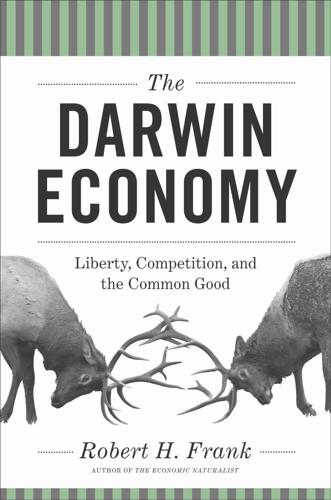
The Darwin Economy: Liberty, Competition, and the Common Good
by
Robert H. Frank
Published 3 Sep 2011
Again, his claim that an efficient solution would be achieved irrespective of whether polluters were held liable for damages was quite explicitly predicated on an assumption that anyone familiar with his earlier work would know he believed to be unrealistic. Coase’s first significant paper, “The Nature of the Firm,” published in 1937, was in fact inspired by his observation that practical difficulties often prevented people from negotiating efficient contracts with one another.10 This paper was based on field research he had conducted in 1932, when as an undergraduate he received a fellowship to travel to the United States to observe the operations of large American corporations.
…
Ronald H. Coase, “The Problem of Social Cost,” Journal of Law and Economics 3, October 1960: 1–44. 224 NOTES TO PAGES 89–106 9. See, for example, A. M. Diamond, “Most Cited Economic Papers and Current Research Fronts,” Journal of Citation Studies 50, Part 2, 1989: 10–15. 10. Ronald H. Coase, “The Nature of the Firm,” Economica, New Series, 4(16), November 1937: 386–405. 11. See, for example, Armen Alchian and Harold Demsetz, “Production, Information Costs, and Economic Organization,” American Economic Review 62, December 1972: 777–795; Richard M. Cyert and James G. March, A Behavioral Theory of the Firm, Englewood Cliffs, NJ: Prentice-Hall, 1963; Michael Jensen and William Meckling, “Theory of the Firm: Managerial Behavior, Agency Costs and Ownership Structure,” Journal of Financial Economics 3(4), 1976: 305–360; Sanford Grossman and Oliver Hart, “Takeover Bids, the Free-Rider Problem, and the Theory of the Corporation,” Bell Journal of Economics 11, Spring 1980: 42–64; and Oliver Williamson, Markets and Hierarchies: Analysis and Antitrust Implications, New York: Free Press, 1975. 12.

WTF?: What's the Future and Why It's Up to Us
by
Tim O'Reilly
Published 9 Oct 2017
DEDICATION For all who work to make tomorrow better than today. CONTENTS Cover Title Page Dedication Introduction: The WTF? Economy Part I: Using the Right Maps 1 Seeing the Future in the Present 2 Toward a Global Brain 3 Learning from Lyft and Uber 4 There Isn’t Just One Future Part II: Platform Thinking 5 Networks and the Nature of the Firm 6 Thinking in Promises 7 Government as a Platform Part III: A World Ruled by Algorithms 8 Managing a Workforce of Djinns 9 “A Hot Temper Leaps O’er a Cold Decree” 10 Media in the Age of Algorithms 11 Our Skynet Moment Part IV: It’s Up to Us 12 Rewriting the Rules 13 Supermoney 14 We Don’t Have to Run Out of Jobs 15 Don’t Replace People, Augment Them 16 Work on Stuff That Matters Acknowledgments Notes Index About the Author Credits Copyright About the Publisher INTRODUCTION: THE WTF?
…
They not only allow for, they reward deep rethinking of the way things work. There are many possible futures. The world as it is is not a given. We can reinvent it. PART II PLATFORM THINKING When the best leader leads, the people say “We did it ourselves.” —Lao-tzu 5 NETWORKS AND THE NATURE OF THE FIRM WHEN DALE AND I LAUNCHED GNN IN 1993, OUR MODEL WAS shaped by our experience as publishers. We curated a catalog that highlighted “the best of” the Web, we took over the NCSA “What’s New” page to announce new sites, and we did other things that made sense in the publishing world we’d grown up in, one of whose key functions was curation.
…
ie=UTF8&node=1600 8589011. 81 income and demographics: Sizing the Internet Opportunity (Sebastopol, CA: O’Reilly, 2004). 82 till the end of 1993: “Robert McCool,” Wikipedia, retrieved March 30, 2017, https://en.wikipedia.org/wiki/Robert_McCool. 82 opposed to the idea of third-party apps on the iPhone: Killian Bell, “Steve Jobs Was Originally Dead Set Against Third-Party Apps for the iPhone,” Cult of Mac, October 21, 2011, http://www.cultofmac.com/125180/steve-jobs-was-originally-dead-set-against-third-party-apps-for-the-iphone/. 81 skeptical of the peer-to-peer model: Stone, The Upstarts, 199–200. 86 “how the world *does* work”: Aaron Levie, Twitter update, August 22, 2013, https://twitter.com/levie/status/370776444013510656. CHAPTER 5: NETWORKS AND THE NATURE OF THE FIRM 90 “Apps can do now what managers used to do”: Esko Kilpi, “The Future of Firms,” Medium, February 6, 2015, https://medium.com/@EskoKilpi/movement-of-thought-that-led-to-airbnb-and-uber-9d4da5e3da3a. 90 “support megacorporations”: Hal Varian, “If There Was a New Economy, Why Wasn’t There a New Economics?

Fred Schwed's Where Are the Customers' Yachts?: A Modern-Day Interpretation of an Investment Classic
by
Leo Gough
Published 22 Aug 2010
When using them, you should always check that: you define the ratio clearly; you apply it in the same way to all the companies; you know what ratio values are typical for the industry you are looking at; and that you are comparing companies that are similar. Remember, also, that the results you get are only educated guesses – they are not absolute facts – and you should only use them to get a ‘feel’ for the nature of the firms. 43 DISCOUNTED CASH FLOW ‘The more financial predictions you make the more business you do and the more commissions you get.’ DEFINING IDEA… I don’t want a lot of good investments; I want a few outstanding ones. ~ PHILIP FISHER, GROWTH INVESTOR Discounted Cash Flow (DCF) is based on the idea that the value of anything, whether an asset or a company, is the sum total of the cash it can generate in the future, adjusted for the present value of that cash.
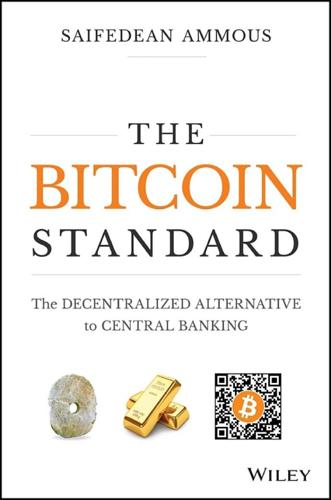
The Bitcoin Standard: The Decentralized Alternative to Central Banking
by
Saifedean Ammous
Published 23 Mar 2018
Dybvig, “Bank Runs, Deposit Insurance, and Liquidity,” Journal of Political Economy, vol. 91, no. 3 (1983): 401–419. 27 Thomas Philippon and Ariell Reshef. “An International Look at the Growth of Modern Finance,” Journal of Economic Perspectives, vol. 27, no. 2 (2013): 73–96. 28 The centralization of credit issuance can be viewed as a government intervention in the operation of Coase's Law, described by Coase in his essay: “The Nature of the Firm,” Economica, vol. 4, no. 16 (1937): 386–405. According to Coase, the reason firms exist is that the individual contracting of tasks can be more expensive because it involves transaction costs, such as search and information, bargaining, contracting, and enforcement costs. A firm will thus grow for as long as it can benefit from doing activities in‐house to overcome higher external contracting costs.
…
The Calculus of Consent: Logical Foundations of Constitutional Democracy. Liberty Fund Indianapolis, 1962. Bunch, Bryan, and Alexander Hellemans. The History of Science and Technology: A Browser's Guide to the Great Discoveries, Inventions, and the People Who Made Them from the Dawn of Time to Today. Houghton Mifflin Harcourt, 2014. Coase, Ronald. “The Nature of the Firm.” Economica 4, no. 16 (1937): 386–405. Courtois, Stephane, Nicolas Werth, Karel Bartosek, Andrzej Paczkowski, Jean‐Louis Panné, and Jean‐Louis Margolin. The Black Book of Communism: Crimes, Terror, Repression. Harvard University Press, 1997. Davidson, James, and William Rees‐Mogg. The Sovereign Individual: The Coming Economic Revolution.

Superminds: The Surprising Power of People and Computers Thinking Together
by
Thomas W. Malone
Published 14 May 2018
That means it can explain other possible results of the same mechanism, such as the evolution of smaller or simpler forms of social organization in situations where that leads to more benefits for more people. CHAPTER 11 1. Friedrich August Hayek, “The Use of Knowledge in Society,” American Economic Review 35, no. 4 (1945): 519–30; Ronald H. Coase, “The Nature of the Firm,” Economica 4, no. 16 (1937): 386–405; Oliver E. Williamson, Markets and Hierarchies (New York: Free Press, 1975); Oliver Hart, Firms, Contracts, and Financial Structure (London: Oxford University Press, 1995); Oliver Hart and Bengt Holmstrom, “The Theory of Contracts,” in Advances in Economic Theory, ed.
…
Lee and Richard Daly, eds., Cambridge Encyclopedia of Hunters and Gatherers (New York: Cambridge University Press, 1999), 1–19. 7. Friedrich August Hayek, “The Use of Knowledge in Society,” The American Economic Review 35, no. 4 (1945): 526–27. Reprinted with permission of publisher. 8. Coase, “The Nature of the Firm,” 386–405; Williamson, Markets and Hierarchies; Hart, Firms, Contracts; Sanford J. Grossman and Oliver D. Hart, “The Costs and Benefits of Ownership: A Theory of Vertical and Lateral Integration,” Journal of Political Economy 94, no. 4 (1986): 691–719, doi:10.1086/261404; Hart, “Theory of Contracts,” 71–155.

You've Been Played: How Corporations, Governments, and Schools Use Games to Control Us All
by
Adrian Hon
Published 14 Sep 2022
In the 1960s, a US CEO’s income was a pitiful twenty times that of a production worker; today, they earn almost three hundred times as much.100 Others have described a global drive, starting from the 1980s, to replace organisations with networks of contracts; APIs are arguably yet another iteration of this trend.101 The idea that a company is basically a collection of contracts originates from economist Ronald Coase’s 1937 essay “The Nature of the Firm.”102 In it, he wondered why we have firms with full-time employees rather than loose groups of independent, self-employed contractors. His answer was that while using contractors would, in theory, be cheaper due to market competition driving the price of labour down, companies would suffer significant transaction costs if they took that route—everything from constantly arguing about costs and worrying about losing trade secrets to spending too much time looking for (and keeping) good workers.
…
Lawrence Mishel and Julia Wolfe, “CEO Compensation Has Grown 940% since 1978,” Economic Policy Institute, August 14, 2019, www.epi.org/publication/ceo-compensation-2018. 101. “In the Eternal Inferno, Fiends Torment Ronald Coase with the Fate of His Ideas,” Yorkshire Ranter, January 31, 2018, www.harrowell.org.uk/blog/2018/01/31/in-the-eternal-inferno-fiends-torment-ronald-coase-with-the-fate-of-his-ideas. 102. Ronald H. Coase, “The Nature of the Firm,” Economica 4, no. 16 (November 1937): 386–405, https://doi.org/10.1111/j.1468-0335.1937.tb00002.x. 103. Blake Droesch, “Amazon Dominates US Ecommerce, Though Its Market Share Varies by Category,” Insider Intelligence, eMarketer, April 27, 2021, www.emarketer.com/content/amazon-dominates-us-ecommerce-though-its-market-share-varies-by-category; Todd W.

Exponential: How Accelerating Technology Is Leaving Us Behind and What to Do About It
by
Azeem Azhar
Published 6 Sep 2021
North, Institutions, Institutional Change and Economic Performance (Cambridge University Press, 1990) <https://doi.org/10.1017/CBO9780511808678>. 45 ‘“No Place for Discontent”: A History of the Family Dinner in America’, NPR, 16 February 2016 <https://www.npr.org/sections/thesalt/2016/02/16/459693979/no-place-for-discontent-a-history-of-the-family-dinner-in-america> [accessed 26 March 2021]. 46 Kathleen Thelen, How Institutions Evolve: The Political Economy of Skills in Germany, Britain, the United States, and Japan (Cambridge, UK: Cambridge University Press, 2004) <https://doi.org/10.1017/CBO9780511790997>. CHAPTER 4: THE UNLIMITED COMPANY 1 R. H. Coase, ‘The Nature of the Firm’, Economica, 4(16), November 1937, pp. 386–405 <https://doi.org/10.1111/j.1468-0335.1937.tb00002.x>. 2 Geoffrey B. West, Scale: The Universal Laws of Growth, Innovation, Sustainability, and the Pace of Life in Organisms, Cities, Economies, and Companies (New York: Penguin Press, 2017), pp. 387–410. 3 Myoung Cha and Flora Yu, ‘Pharma’s First-to-Market Advantage’, McKinsey & Company, 1 September 2014 <https://www.mckinsey.com/industries/pharmaceuticals-and-medical-products/our-insights/pharmas-first-to-market-advantage> [accessed 23 September 2020]. 4 ‘Car Registrations’, SMMT <https://www.smmt.co.uk/vehicle-data/car-registrations/> [accessed 23 September 2020]. 5 ‘TV Manufacturers: LCD TV Market Share Worldwide 2018’, Statista <https://www.statista.com/statistics/267095/global-market-share-of-lcd-tv-manufacturers/> [accessed 23 September 2020]. 6 ‘Standard Ogre’, The Economist, 23 December 1999 <https://www.economist.com/business/1999/12/23/standard-ogre> [accessed 23 September 2020]. 7 ‘Teen IPhone Ownership Hits an All-Time High in Long-Running Survey’, MacRumors, 8 April 2020 <https://www.macrumors.com/2020/04/08/teen-iphone-ownership-hits-all-time-high/> [accessed 21 April 2021]. 8 Keach Hagey and Suzanne Vranica, ‘How Covid-19 Supercharged the Advertising “Triopoly” of Google, Facebook and Amazon’, Wall Street Journal, 19 March 2021 <https://www.wsj.com/articles/how-covid-19-supercharged-the-advertising-triopoly-of-google-facebook-and-amazon-11616163738> [accessed 13 April 2021]. 9 Liyin Yeo, ‘The U.S.
…
Rothstein, ‘The Law of Genetic Privacy: Applications, Implications, and Limitations’, Journal of Law and the Biosciences, 6(1), 2019, pp. 1–36 <https://doi.org/10.1093/jlb/lsz007> Clegg, Nick, ‘You and the Algorithm: It Takes Two to Tango’, Medium, 31 March 2021 <https://nickclegg.medium.com/you-and-the-algorithm-it-takes-two-to-tango-7722b19aa1c2> [accessed 31 March 2021] Coase, R. H., ‘The Nature of the Firm’, Economica, 4(16), November 1937, pp. 386–405 <https://doi.org/10.1111/j.1468-0335.1937.tb00002.x> Cortada, James W., The Computer in the United States: From Laboratory to Market (Armonk, NY: M. E. Sharpe, 1993) Curmi, Elizabeth, Aakash Doshi, Gregory R. Badishkanian, Nick Coulter, David Driscoll, P.J.

The Innovators: How a Group of Inventors, Hackers, Geniuses and Geeks Created the Digital Revolution
by
Walter Isaacson
Published 6 Oct 2014
Linus Torvalds, “Free Minix-like Kernel Sources for 386-AT,” posting to Newsgroups: comp.os.minix, Oct. 5, 1991, http://www.cs.cmu.edu/~awb/linux.history.html. 135. Torvalds and Diamond, Just for Fun, 87, 93, 97, 119. 136. Gary Rivlin, “Leader of the Free World,” Wired, November 2003. 137. Yochai Benkler, The Penguin and the Leviathan: How Cooperation Triumphs over Self-Interest (Crown, 2011); Yochai Benkler, “Coase’s Penguin, or, Linux and the Nature of the Firm,” Yale Law Journal (2002), http://soc.ics.uci.edu/Resources/bibs.php?793. 138. Eric Raymond, The Cathedral and the Bazaar (O’Reilly Media, 1999), 30. 139. Alexis de Tocqueville, Democracy in America (originally published 1835–40; Packard edition), Kindle location 3041. 140. Torvalds and Diamond, Just for Fun, 122, 167, 120, 121. 141.
…
Larry Sanger, “Why Wikipedia Must Jettison Its Anti-Elitism,” Dec. 31, 2004, www.LarrySanger.org. 105. Wikipedia press release, Jan. 15, 2002, http://en.wikipedia.org/wiki/Wikipedia:Press_releases/January_2002. 106. Author’s interview with Jimmy Wales. 107. Shirky, “Wikipedia—An Unplanned Miracle.” 108. Yochai Benkler, “Coase’s Penguin, or, Linux and the Nature of the Firm,” Yale Law Journal (2002), http://soc.ics.uci.edu/Resources/bibs.php?793; Yochai Benkler, The Penguin and the Leviathan: How Cooperation Triumphs over Self-Interest (Crown, 2011). 109. Daniel Pink, “The Buck Stops Here,” Wired, Mar. 2005; Tim Adams, “For Your Information,” Guardian, June 30, 2007; Lord Emsworth user page, http://en.wikipedia.org/wiki/User:Lord_Emsworth; Peter Steiner, New Yorker cartoon, July 5, 1993, at http://en.wikipedia.org/wiki/On_the_Internet,_nobody_knows_you’re_a_dog. 110.
…
“Accelerating the Co-Evolution,” Doug Engelbart Institute, http://www.dougengelbart.org/about/co-evolution.html; Thierry Bardini, Bootstrapping: Douglas Engelbart, Coevolution, and the Origins of Personal Computing (Stanford, 2000). 30. Nick Bilton, Hatching Twitter (Portfolio, 2013), 203. 31. Usually misattributed to Thomas Edison, although there is no evidence he ever said it. Often used by Steve Case. 32. Yochai Benkler, “Coase’s Penguin, or, Linux and the Nature of the Firm,” Yale Law Journal (2002). 33. Steven Johnson, “The Internet? We Built That,” New York Times, Sept. 21, 2012. 34. Author’s interview with Larry Page. The quote form Steve Jobs comes from an interview I did with him for my previous book. 35. Kelly and Hamm, Smart Machines, 7. PHOTO CREDITS Lovelace: Hulton Archive/Getty Images Lord Byron: © The Print Collector/Corbis Babbage: Popperfoto/Getty Images Difference Engine: Allan J.

The Firm
by
Duff McDonald
Published 1 Jun 2014
They said it.”40 Indeed, when one of the three-star generals wrote a book for Harvard Business Press on the management lessons learned in the Gulf War, BusinessWeek advised readers to skip the book and read the McKinsey Quarterly article by Bose and Sharman instead. The shift to a knowledge culture that had begun under Daniel and picked up pace under Gluck was reflected in the nature of the firm’s partner conferences. In 1980, long before the McKinsey consultants had truly understood the need for a radical change in perspective, the conference was in Vienna. McKinsey partners and their wives stayed at the most expensive hotel in the city and were taken in horse-drawn carriages to a private concert of the Vienna Boys’ Choir.
…
In the search for answers in the midst of the Kumar/Gupta scandal, McKinsey turned inward. And it didn’t like what it saw, which was a firm that had deceived itself into thinking that the Gupta-era excesses had been left behind. It had merely papered over the problem and missed a fundamental—and permanent—change in the nature of the firm. At its current size, McKinsey could no longer assume that Marvin Bower’s principles would endure. “The stuff with Anil [Kumar] was noteworthy in the effect it had on people,” said Michelle Jarrard, director of firm personnel. “It was a disappointment, and we can’t pretend it’s not. You might try to tell a silver-lining story about the fact that it caused us to increase our vigilance going forward, but it’s fair to say that it hurt.”26 One obvious issue raised by the Kumar incident, in particular, is that of the senior person too far out on the fringe of a large and growing company.

Governing the Commons: The Evolution of Institutions for Collective Action
by
Elinor Ostrom
Published 29 Nov 1990
In Dynamic Optimization and Mathematical Eco nomics, ed. P. T. Liu, pp. 117-32. New York: Plenum Press. Clark, C. W., G. Munro, and A. Charles. 1985. Fisheries: Dynamics, and Un certainty, in Progress in Natural Resource Economics, ed. A. Scott, pp. 99-119. Oxford University Press (Clarendon Press). Coase, R. H. 1937. The Nature of the Firm. Economica 4:386-405. Coase, R. H. 1960. The Problem of Social Cost. Journal ofLaw Economics 3: 1-44. Cole, J. W., and E. R. Wolf. 1974. The Hidden Frontier: Ecology and Ethnicity in an Alpine Valley. New York: Academic Press. Coleman, J. S. 1987a. Externalities and Norms in a Linear System of Action.

The Limits of the Market: The Pendulum Between Government and Market
by
Paul de Grauwe
and
Anna Asbury
Published 12 Mar 2017
Rogoff, This Time is Different: Eight Centuries of Financial Folly (Princeton, NJ: Princeton University Press, ). . Michael J. Sandel, What Money Can’t Buy: The Moral Limits of Markets (London: Allen Lane, ). . Kenneth J. Arrow, ‘Gifts and exchanges’, Philosophy and Public Affairs, / (), pp. –. . Ronald Coase, ‘ The Nature of the Firm’, Economica, / (November ), pp. –. . See Frans de Waal, Our Inner Ape: The Best and Worst of Human Nature (London: Granta Books, ). See also Matt Ridley, The Origins of Virtue (London: Penguin Books, ). . Erik Brynjolfsson and Andrew McAfee, Race Against the Machine: How the Digital Revolution is Accelerating Innovation, Driving Productivity, and Irreversibly Transforming Employment and the Economy (Lexington, MA: Digital Frontier Press, ). .
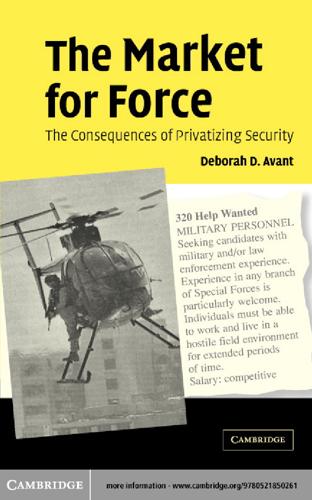
The Market for Force: The Consequences of Privatizing Security
by
Deborah D. Avant
Published 17 Oct 2010
Oliver Williamson, “Public and Private Bureaucracies: A Transaction Cost Economics Perspective,” Journal of Law, Economics and Organization, Vol. 15, No. 1 (1999). See Oliver Williamson, Markets and Hierarchies: Analysis and Anti-Trust Implications (New York: Free Press, 1975). See also, R. H. Coase, “The Nature of the Firm,” Economica Vol. 4, No. 16 (November 1937); H. A. Simon, Administrative Behavior (New York: Macmillan 1961); A. A. Alchian and H. Demsetz, “Production, Information Costs, and Economic Organization,” American Economic Review Vol. 62 (December 1972). Williamson, Markets and Hierarchies, pp. 8–10.
…
Clark, Wesley, Waging Modern War: Bosnia, Kosovo, and the Future of Conflict (New York: Public Affairs, 2001). 272 Bibliography Clarke, S. J. G., The Congo Mercenary ( Johannesburg: SAIIA Press, 1968). Clynes, Tom, “Heart Shaped Bullets,” Observer Magazine (24 November 2002), 34. Coase, Ronald, “The Regulated Industries: Discussion,” American Economic Review Vol. 54 (May 1964), 192–197. Coase, R. H., “The Nature of the Firm,” Economica Vol. 4, No. 16 (November 1937), 386–405. Cobb, Charles, Jr., “Chad–Cameroon Pipeline Considered by Congressional Subcommittee,” allAfrica.com NEWS (18 April 2002) (available at http:// allafrica.com/stories/printable/200204180864.html). Cock, Jacklyn and Peggie Mckenzie, From Defense to Development: Redirecting Military Resources in South Africa, (Ottowa: International Development Research Centre, 1998).

Blockchain Revolution: How the Technology Behind Bitcoin Is Changing Money, Business, and the World
by
Don Tapscott
and
Alex Tapscott
Published 9 May 2016
So why would any established firm—particularly ones that make their money off other people’s data, operate largely behind closed doors, and suffer surprisingly little in data breach after data breach—want to leverage blockchain technologies to distribute power, increase transparency, respect user privacy and anonymity, and include far more people who can afford far less than those already served? Transaction Costs and the Structure of the Firm Let’s start with a little economics. In 1995, Don used Nobel Prize–winning economist Ronald Coase’s theory of the firm to explain how the Internet would affect the architecture of the corporation. In his 1937 paper “The Nature of the Firm,” Coase identified three types of costs in the economy: the costs of search (finding all the right information, people, resources to create something); coordination (getting all these people to work together efficiently); and contracting (negotiating the costs for labor and materials for every activity in production, keeping trade secrets, and policing and enforcing these agreements).
…
[t]ransactions can be organized within the firm at less cost than if the same transactions were carried out through the market. The limit to the size of the firm [is reached] when the costs of organizing additional transactions within the firm [exceed] the costs of carrying the same transactions in the market.” As cited in Oliver Williamson and Sydney G. Winter, eds., The Nature of the Firm (New York and Oxford: Oxford University Press, 1993), 90. 6. Oliver Williamson, “The Theory of the Firm as Governance Structure: From Choice to Contract,” The Journal of Economic Perspectives 16(3) (Summer 2002) 171–95. 7. Ibid. 8. Peter Thiel with Blake Masters, Zero to One: Notes on Startups, or How to Build the Future (New York: Crown Business, 2014). 9.
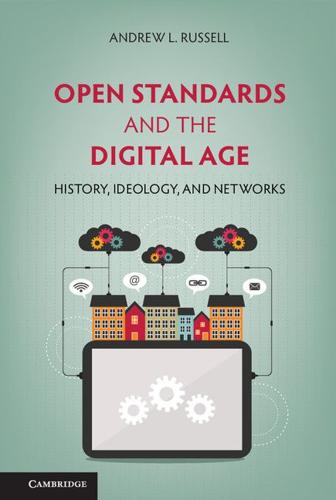
Open Standards and the Digital Age: History, Ideology, and Networks (Cambridge Studies in the Emergence of Global Enterprise)
by
Andrew L. Russell
Published 27 Apr 2014
Usselman, Regulating Railroad Innovation: Business, Technology, and Politics in America, 1840–1920 (New York: Cambridge University Press, 2002). 5 Annual Report of the Directors of American Telephone and Telegraph Company to the Stockholders for the Year Ending December 31, 1909 (Boston: Geo. H. Ellis Co., Printers, 1910), 18. 6 Walter G. Vincenti, What Engineers Know and How They Know It: Analytical Studies from Aeronautical History (Baltimore: The Johns Hopkins University Press, 1990), 7–9. 7 Ronald H. Coase, “The Nature of the Firm,” Economica 4 (1937): 386–405. 8 The Bell Telephone Company was incorporated in 1877, and kept that name until 1879. From 1879 to 1880 it was the National Bell Telephone Company, which was reincorporated as the American Bell Telephone Company (1880–1899). The American Telephone and Telegraph Company was incorporated as a long-distance firm in 1885, and became the parent company for the Bell interests on December 31, 1899.
…
Scott, Seeing Like a State: How Certain Schemes to Improve the Human Condition Have Failed (New Haven, CT: Yale University Press, 1999); Timothy Schoechle, Standardization and Digital Enclosure: The Privatization of Standards, Knowledge, and Policy in the Age of Global Information Technology (Hershey, PA: IGI Global, 2009). 10 Ronald H. Coase, “The Nature of the Firm,” Economica New Series, 4 (1937): 386–405; Oliver E. Williamson, “Transaction Cost Economics: The Natural Progression,” in Karl Grandin, Les Prix Nobel (Stockholm: Nobel Foundation, 2010); Naomi R. Lamoreaux, Daniel M. G. Raff, and Peter Temin, “Beyond Markets and Hierarchies: Toward a New Synthesis of American Business History,” American Historical Review 108 (2003): 404–433; Naomi R.
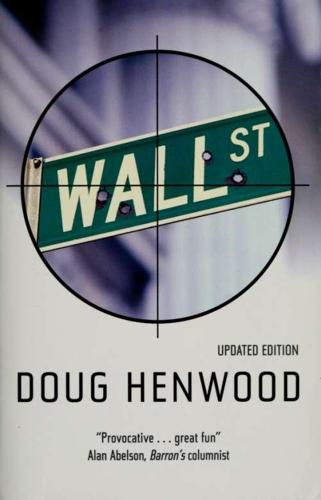
Wall Street: How It Works And for Whom
by
Doug Henwood
Published 30 Aug 1998
Clarke, Simon (1993). Marx's Theory of Crisis (London: Macmillan). Cleaver, Harry (1995). "The Subversion of Money-as-Command In the Current Crisis," in Bonefeld and HoUoway 1995, pp. 141-177. Coakley, Jerry, and Laurence Harris (1983). City of Capital (Oxford: Basil Blackwell). Coase, Ronald H. (1937). "The Nature of the Firm," Economica 4, pp. 386-405, reprinted in Williamson and Winter (1993), Chapter 2. Cochrane, James L. (1991). "The Internationalization of Trading," speech delivered to a Financial Times conference, London, April 22. Cockburn, Alexander (1995). The Golden Age Is In Us (New York and London: Verso).
…
The Economics of Investment in R&D," Finance and Economics Discussion Series (FEDS) No. 95-39 (Washington: Federal Reserve Board, Division of Research and Statistics, August). Williamson, Oliver E. (1988). "Corporate Finance and Corporate Governance,"/ourna/ of Financed (July), pp. 567-591. — (1993). "The Logic of Economic Organization," in Williamson and Winter (1993), pp. 90-116. Williamson, Oliver E. and Sidney G. Winter, eds. (1993). The Nature of the Firm: Origins, Evolution, and Development Wev^ York and Oxford: Oxford University Press). Wilmsen, Steven (1991). Silverado: Neil Bush and the Savings & Loan 5c«n<i«/(Washington: National Press Books). Winslow, Ted (1992). ""Psychoanalysis and Keynes's Account of the Psychology of the Trade Cycle," in Gerrard and Hillard (1992), pp. 212-230.
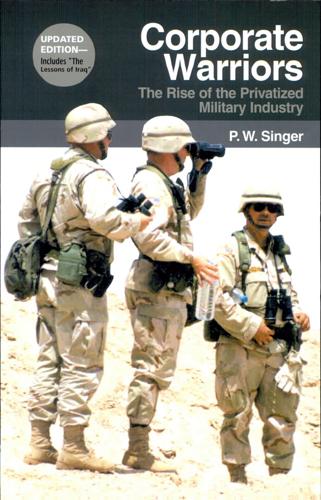
Corporate Warriors: The Rise of the Privatized Military Industry
by
Peter Warren Singer
Published 1 Jan 2003
Poll results reported at www .techcentralstateion.com/defense.aspj September 22, 2001. 19. Global Coalition for Africa, African Social and Economic Trends. Annual Report 1999/ 2000. 20. Elizabeth Rubin, "An Army of One's Own." Harper's Magazine, February 1997. 21. Examples include Ronald Coasc, "The Nature of the Firm." Economical (1937): 3^6- 405; Thrain Eggcrtson. Economic Behavior and Institutions (New York: Cambridge University Press, 1990); Douglass C. North. Institutions, Institutional Change, and Economic Performance (New York: Cambridge University Press. 1990); Roland Vaubel and Thomas Willctt, The Political Economy of International Organizations (Boulder, Colo.: Wcstvicw: Press, 1991); "War, Chaos, and Business: Modern Business Strategy," Kettle Creek Corporation Report, 2001. 22.
…
January "CIS Pilots Fight in Ethiopia." hvestia. May 23, 2000, p. 4. Clapham, Christopher. Africa and the International System: The Politics of State Survival. Cambridge: Cambridge University Press, 199O. Coase, Ronald. "The Lighthouse in Economics." Journal of Law and Economics 17 (October 1974): 357-37O. . "The Nature of the Firm." Economical (1937): 386-405. Cohen, Roger. "After Aiding Croatian Army, U.S. Xow Seeks to Contain It." New York Times, October 28, 1995, p. 5. Collier, Paul, and Alike Hoeffler. "Greed and Grievance in Civil War." World Bank Policy Research Paper, no. 2355, May 2000. "Colombian Rebels Threaten U.S.
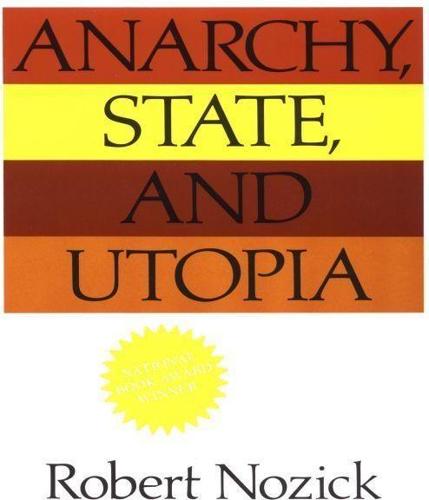
Anarchy State and Utopia
by
Robert Nozick
Published 15 Mar 1974
.: Harvard University Press, 1971. 16 Rawls, Theory of Justice, p. 4. 17 See Milton Friedman, Capitalism and Freedom (Chicago: University of Chicago Press, 1962), p. 165. 18 On the question of why the economy contains firms (of more than one person), and why each individual does not contract and recontract with others, see Ronald H. Coase, “The Nature of the Firm,” in Readings in Price Theory. ed. George Stigler and Kenneth Boulding (Homewood, III.: Irwin, 1952); and Armen A. Alchian and Harold Demsetz, “Production, Information Costs and Economic Organization,” American Economic Review, 1972, 777-795. 19 We do not, however, assume here or elsewhere the satisfaction of those conditions specified in economists’ artificial model of so-called “perfect competition.”
…
New York: Macmillan, 1950. Calabresi, Guido and Melamed, A. Douglas. “Property Rules, Liability and Inalienability. Harvard Law Review 85, no. 6 (1972):1089-1128. Chomsky, Noam. “Introduction” to Daniel Guerin, Anarchism: From Theory to Practice. New York: Monthly Review Press, 1970. Coase, Ronald. “The Nature of the Firm.” In George Stigler and K. Boulding, eds., Readings in Price Theory. Chicago: Irwin, 1952. Coase, Ronald. “The Problem of Social Costs.” Journal of Law and Economics, 3 (1960): I-44. Crow, James and Kimura, Motoo. Introduction to Population Genetics Theory. New York: Harper & Row. 1970.
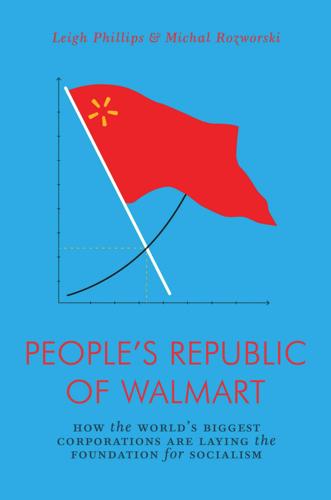
The People's Republic of Walmart: How the World's Biggest Corporations Are Laying the Foundation for Socialism
by
Leigh Phillips
and
Michal Rozworski
Published 5 Mar 2019
Having completed his tour of American business and witnessed its inner workings, upon his return to Britain, he compiled his thoughts in a 1932 lecture to University of Dundee students little younger than himself, although it would be another five years before he published his results. The resulting text, “The Nature of the Firm”, features a quote from economist Dennis Robertson—a close collaborator of famed British macroeconomist John Maynard Keynes, and the originator of the concept of the “liquidity trap”—in which Robertson talks of the curiosity of the very existence of companies, unflatteringly describing them as “islands of conscious power in this ocean of unconscious cooperation, like lumps of butter coagulating in a pail of buttermilk.”
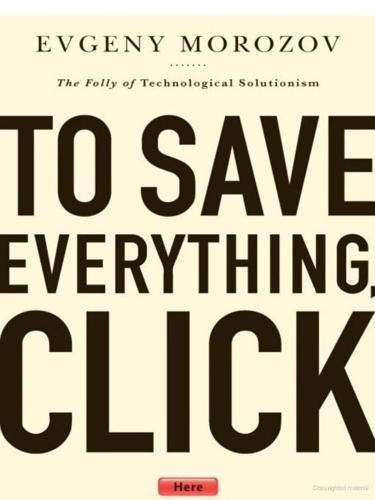
To Save Everything, Click Here: The Folly of Technological Solutionism
by
Evgeny Morozov
Published 15 Nov 2013
Anderson, “The Difference between Online Knowledge and Truly Open Knowledge,” The Atlantic, February 3, 2012, http://www.theatlantic.com/technology/archive/2012/02/the-difference-between-online-knowledge-and-truly-open-knowledge/252516 . 39 “At the very same time [that “the Internet” is blamed]”: Weinberger, Too Big to Know, xii. 40 Here Comes Everybody: Clay Shirky, Here Comes Everybody: The Power of Organizing without Organizations (New York: Penguin, 2009). 40 Susanne Lohmann’s explanation of the 1989 protests in East Germany: Susanne Lohmann, “The Dynamics of Informational Cascades: The Monday Demonstrations in Leipzig, East Germany, 1989–91,” World Politics 47, no. 1 (October 1, 1994): 42–101. 40 Ronald Coase’s theory of the firm: Ronald Coase, “The Nature of the Firm,” Economica, 4 (1937): 386–405. 40 in order to explain the 1989 protests: Lohmann, “The Dynamics of Informational Cascades.” 41 “Generalizing about social movements”: Stephen Kotkin, Uncivil Society: 1989 and the Implosion of the Communist Establishment (New York: Random House Digital, Inc., 2009), 147. 41 “behavior is motivation that has been filtered through opportunity”: Clay Shirky, Cognitive Surplus: How Technology Makes Consumers into Collaborators, reprint ed.
…
(New York: Penguin Books, 2011), 195. 41 “share a propensity to engage in method-driven research”: Ian Shapiro, The Flight from Reality in the Human Sciences (Princeton, NJ: Princeton University Press, 2007), 68. 41 “it may be shaped by enthusiasm for the collective objectives”: ibid., 76. 42 “a dispassionate search for the causes”: ibid., 88. 43 Yochai Benkler also draws heavily on Coase: Yochai Benkler, “Coase’s Penguin, or, Linux and ‘The Nature of the Firm,’” Yale Law Journal 112, no. 3 (December 1, 2002): 369–446. 43 “the Internet not only drops transaction and collaboration costs in business”: “Don Tapscott: Four Principles for the Open World,” TED, June 2012, http://www.ted.com/talks/don_tapscott_four_principles_for_the_open_world_1.html?
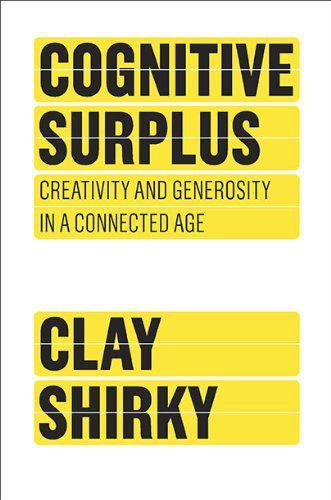
Cognitive Surplus: Creativity and Generosity in a Connected Age
by
Clay Shirky
Published 9 Jun 2010
Mencken, A Mencken Chrestomathy: His Own Selection of His Choicest Writings (New York: Vintage, 1982): 617. 114 Behlendorf was the primary programmer for Apache: “Brian Behlendorf, Founding Member of the Apache Software Foundation Speaks on How Open Source Developers Can Save the World,” Bitsource, October 6, 2009, The Bitsource, http://www.thebitsource.com/2009/10/06/brian-behlendorf-apachecon-keynote (accessed January 9, 2010). 116 People do get paid to work on it: John Naughten, “The High Tech Gift Culture,” A Brief History of the Future: Origins of the Internet (New York: The Overlook Press, 2000); also at http://www.briefhistory.com/pages/extract4.htm (accessed January 9, 2010). 119 upended the idea that humans always determine value rationally: Dan Ariely, Predictably Irrational: The Hidden Forces That Shape Our Decisions (New York: Harper, 2008). 119 commons-based peer production: Yochai Benkler, “Coase’s Penguin, or, Linux and the Nature of the Firm,” Yale Law Journal 112 (2002): 371-99. 120 Napster users could share a list of the songs: Spencer E. Ante, “Napster’s Shawn Fanning: The Teen Who Woke Up Web Music,” BusinessWeek, April 12, 2000, Bloomberg, http://www.businessweek.com/ebiz/0004/em0412.htm (accessed January 9, 2010). 120 Napster acquired tens of millions of users in less than two years : Benny Evangelista, “News Analysis: Internet Music Will Still Play on Despite Napster’s Uncertain Future,” San Francisco Chronicle, February 18, 2001, Hearst Communications, http://www.sfgate.com/c/a/2001/02/18/BU39387.DTL (accessed January 9, 2010). 124 “He who receives ideas from me”: Quoted in John Pitman, “Open Access to Professional Information,” IMS Bulletin 36.8 (2007): 13. 125 “Triumph of the Default”: Kevin Kelly, “Triumph of the Default,” The Technium, June 22, 2009, Creative Commons, http://www.kk.org/thetechnium/archives/2009/06/triumph_of_the.php (accessed January 9, 2010). 126 tired of their country’s divisive politics: Sabrina Tavernise, “Young Pakistanis Take One Problem into Their Own Hands,” The New York Times, May 18, 2009, http://www.nytimes.com/2009/05/19/world/asia/19trash.html (accessed January 9, 2010).
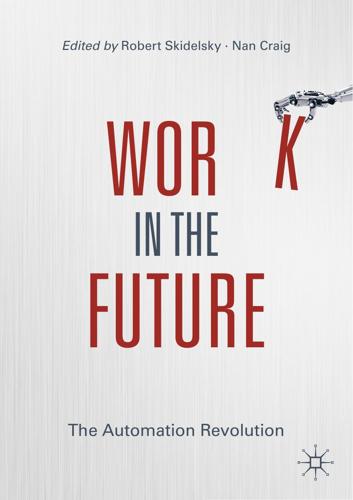
Work in the Future The Automation Revolution-Palgrave MacMillan (2019)
by
Robert Skidelsky Nan Craig
Published 15 Mar 2020
Economica, 75, 362–383. Bloom, N., Sadun, R., & Van Reenen, J. (2012). The Organization of Firms Across Countries. Quarterly Journal of Economics, 127(4), 1663–1705. Cheuvreux, M. & Darmaillacq, C. (2014). Unionisation in France: paradoxes, challenges and outlook. TRESOR-ECONOMICS 129, 1-12. Coase, R. (1937). The Nature of the Firm. Economica, 4(16), 386–405. Blackwell Publishing. Coe-Rexecode, 2016. La durée effective annuelle du travail en France et en Europe. Document de travail n°59, Paris : Coe-Rexecode. Elster, J. (1985). Making Sense of Marx. Cambridge, UK: Cambridge University Press. Galbraith, J. K. (2004).

Makers
by
Chris Anderson
Published 1 Oct 2012
In the mid-1930s, Ronald Coase, then a recent London School of Economics graduate, was musing over what to many people might have seemed a silly question: Why do companies exist? Why do we pledge our allegiance to an institution and gather in the same building to get things done? His eventual answer, which he published in his landmark 1937 article “The Nature of the Firm,”33 was this: companies exist to minimize “transaction costs”—time, hassle, confusion, mistakes. When people share a purpose and have established roles, responsibilities, and modes of communication, it’s easy to make things happen. You simply turn to the person in the next cubicle and ask that individual to do his or her job.

Reinventing Capitalism in the Age of Big Data
by
Viktor Mayer-Schönberger
and
Thomas Ramge
Published 27 Feb 2018
If firms could utilize the technical breakthroughs we describe, reshape the flow of information within them, and capture similar efficiency gains, it would be straightforward. Alas, as we’ll explain, the technical advances that underlie and power data-richness can’t be used as easily in firms as they can in markets. They are constrained by the way information flows in firms. To adapt, the nature of the firm will need to be reimagined. Possible responses to the challenge from data-rich markets involve finding ways to either more narrowly complement or emulate them. Firms might automate decision-making of (certain) managerial decisions and introduce more marketlike features, such as decentralized information flows and transaction-matching.
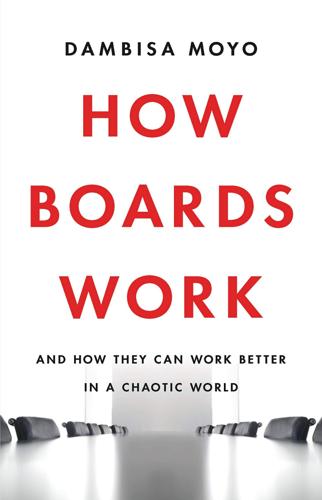
How Boards Work: And How They Can Work Better in a Chaotic World
by
Dambisa Moyo
Published 3 May 2021
“Philadelphia Beverage Tax.” Payments, Assistance, and Taxes. Last modified January 8, 2020. www.phila.gov/services/payments-assistance-taxes/business-taxes/philadelphia-beverage-tax/. Climate Action 100+. “Global Investors Driving Business Transition.” www.climateaction100.org. Coase, R. H. “The Nature of the Firm.” Economica 4, no. 16 (November 1937): 386–405. www.jstor.org/stable/2626876?seq=1#page_scan_tab_contents. Cohan, Peter. “Delays in Boeing’s 737 MAX and 777X Could Weigh on Stock.” Forbes, June 6, 2019. www.forbes.com/sites/petercohan/2019/06/06/delays-in-boeings-737-max-and-777x-could-weigh-on-stock/#61de1af3e678.
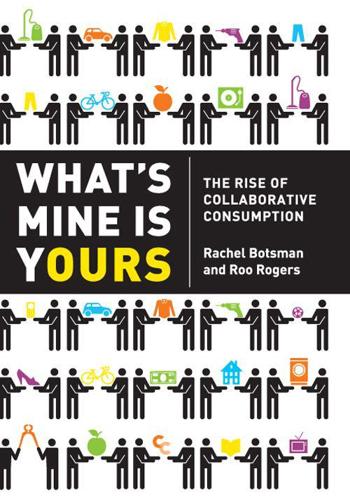
What's Mine Is Yours: How Collaborative Consumption Is Changing the Way We Live
by
Rachel Botsman
and
Roo Rogers
Published 2 Jan 2010
Collapse of “Transaction Costs” When we asked Beal which are the most commonly listed items on Freecycle, he explained that “there isn’t one particular thing” but instead massive categories of “inconvenient things” (old pianos, sofas, and televisions) and “unusual items” (disco balls, fish tanks, and even stuffed animals). These are the items that would have been a pain to lug to the dump (and sometimes you would even have to pay to dispose of them) or tricky to unload on a neighbor. The transaction costs to ensure they were kept in use, not in landfill, would have been high. In his paper “The Nature of the Firm,” economist and Nobel laureate Ronald Coase coined the term “transaction costs” to refer to the cost of making any form of exchange or participating in a market.3 If you go to the supermarket, for example, and buy some groceries, your costs are not just the price of the groceries but the energy, time, and effort required to write your list, travel to and from the store, wheel around your cart and choose your products, wait in the checkout line, and unpack and put away the groceries when you get back home.

Social Life of Information
by
John Seely Brown
and
Paul Duguid
Published 2 Feb 2000
The Visible Hand: The Managerial Revolution in American Business. Cambridge: Harvard University Press. Chellappa, Ramanath, Anitesh Barua, and Andrew B. Whinston. 1997. "E3: An Electronic Infrastructure for a Virtual University." Communications of the ACM 40 (9): 56 58. Page 292 Coase, Ronald H. 937. "The Nature of the Firm." Economica NS 4 (16): 386 405. Coffman, K.G., and Andrew M. Odlyzko. 1998. "The Size and Growth Rate of the Internet." FirstMonday [Online] 3 (10). Available: http://www.firstmonday.dk/issues/issue3_10/coffman/ [1999, July 21]. Cole, Robert. 1999. Managing Quality Fads. New York: Oxford University Press.

Skin in the Game: Hidden Asymmetries in Daily Life
by
Nassim Nicholas Taleb
Published 20 Feb 2018
Ironically, by being beggars, they had the equivalent of f*** you money, which we can more easily get by being at the lowest rung than by joining the income-dependent classes. Complete freedom is the last thing you want if you have an organized religion to run. Total freedom for your employees is also a very, very bad thing if you have a firm to run, so this chapter is about the question of employees and the nature of the firm and other institutions. Benedict’s instruction manual aims explicitly at removing any hint of freedom from the monks under the principles of stabilitate sua et conversatione morum suorum et oboedientia—“stability, conversion of manners, and obedience.” And of course monks are put through a probation period of one year to see if they are sufficiently obedient.

After the Gig: How the Sharing Economy Got Hijacked and How to Win It Back
by
Juliet Schor
,
William Attwood-Charles
and
Mehmet Cansoy
Published 15 Mar 2020
“Towards Community-Centered Support for Peer-to-Peer Service Exchange: Rethinking the Timebanking Metaphor.” In Proceedings of the SIGCHI Conference on Human Factors in Computing Systems, 2975–84. New York: ACM Press. https://doi.org/10.1145/2556288.2557061. Benkler, Yochai. 2002. “Coase’s Penguin, or, Linux and ‘The Nature of the Firm.’ ” Yale Law Journal 112 (3): 369–446. ———. 2004. “Sharing Nicely: On Shareable Goods and the Emergence of Sharing as a Modality of Economic Production.” Yale Law Journal 114 (2): 273–358. ———. 2006. The Wealth of Networks: How Social Production Transforms Markets and Freedom. New Haven, CT: Yale University Press. ———. 2013.

The Wealth of Networks: How Social Production Transforms Markets and Freedom
by
Yochai Benkler
Published 14 May 2006
‹http://www.clickworkers.arc.nasa.gov/documents› /abstract.pdf. 24. J. Giles, "Special Report: Internet Encyclopedias Go Head to Head," Nature, December 14, 2005, available at ‹http://www.nature.com/news/2005/051212/full/438900a.html›. 25. ‹http://www.techcentralstation.com/111504A.html›. 26. Yochai Benkler, "Coase's Penguin, or Linux and the Nature of the Firm," Yale Law Journal 112 (2001): 369. 27. IBM Collaborative User Experience Research Group, History Flows: Results (2003), ‹http://www.research.ibm.com/history/results.htm›. 28. For the full argument, see Yochai Benkler, "Some Economics of Wireless Communications," Harvard Journal of Law and Technology 16 (2002): 25; and Yochai Benkler, "Overcoming Agoraphobia: Building the Commons of the Digitally Networked Environment," Harvard Journal of Law and Technology 11 (1998): 287.
…
‹http://www.clickworkers.arc.nasa.gov/documents› /abstract.pdf. 24. J. Giles, "Special Report: Internet Encyclopedias Go Head to Head," Nature, December 14, 2005, available at ‹http://www.nature.com/news/2005/051212/full/438900a.html›. 25. ‹http://www.techcentralstation.com/111504A.html›. 26. Yochai Benkler, "Coase's Penguin, or Linux and the Nature of the Firm," Yale Law Journal 112 (2001): 369. 27. IBM Collaborative User Experience Research Group, History Flows: Results (2003), ‹http://www.research.ibm.com/history/results.htm›. 28. For the full argument, see Yochai Benkler, "Some Economics of Wireless Communications," Harvard Journal of Law and Technology 16 (2002): 25; and Yochai Benkler, "Overcoming Agoraphobia: Building the Commons of the Digitally Networked Environment," Harvard Journal of Law and Technology 11 (1998): 287.
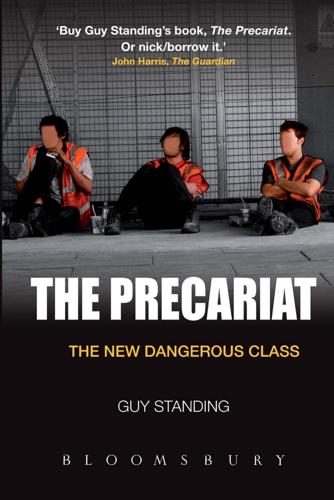
The Precariat: The New Dangerous Class
by
Guy Standing
Published 27 Feb 2011
Chellaney, B. (2010), ‘China Now Exports Its Convicts’, Japan Times Online, 5 July. Available at http://search.japantimes.co.jp/print/eo20100705bc.html [accessed 2 December 2010]. Choe, S.-H. (2009), ‘South Korea Fights Slump through Hiring, Not Firing’, International Herald Tribune, 2 April, pp. 1, 4. 184 BIBLIOGRAPHY 185 Coase, R. H. (1937), ‘The Nature of the Firm’, Economica, 4(16): 386–405. Cohen, D. (2009), Three Lectures on Post-Industrial Society, Cambridge, MA: Massachusetts Institute of Technology Press. Cohen, N. (2010), ‘Now, More than Ever, the Poor Need a Voice’, Observer, 7 October, p. 33. Coleman, D. (2010), ‘When Britain Becomes “Majority Minority”’, Prospect, 17 November.
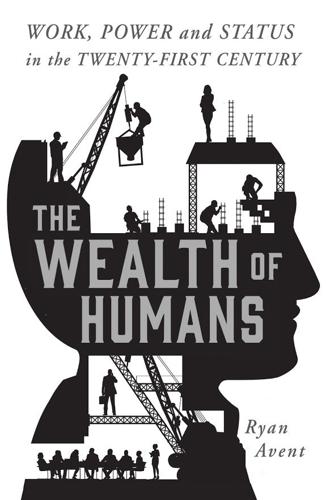
The Wealth of Humans: Work, Power, and Status in the Twenty-First Century
by
Ryan Avent
Published 20 Sep 2016
Smith, The Wealth of Nations. 17. Acemoglu, Daron, and Robinson, James A., Why Nations Fail: The Origins of Power, Prosperity, and Poverty (London: Profile Books, 2012) 5. The Firm as an Information-Processing Organism 1. OECD, Entrepreneurship at a Glance 2015, August 2015. 2. Coase, R. H., ‘The Nature of the Firm’, Economica, Vol. 4, No. 16 (Nov. 1937). 3. Ocean Tomo, ‘Annual Study of Intangible Asset Market Value’, LLC, 2015. 4. Clayton M. Christensen (1952–), Kim B. Clark Professor of Business Administration at the Harvard Business School, and author of The Innovator’s Dilemma: When New Technologies Cause Great Firms to Fail (Cambridge, MA: Harvard Business Review Press, 1997). 5.
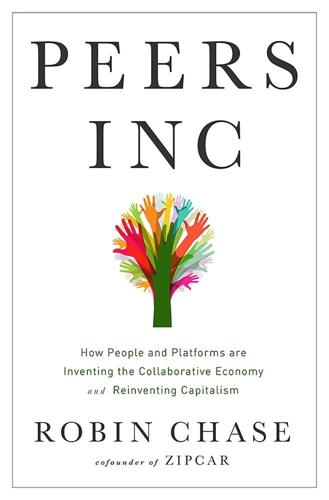
Peers Inc: How People and Platforms Are Inventing the Collaborative Economy and Reinventing Capitalism
by
Robin Chase
Published 14 May 2015
In total, companies building platforms to tap into excess capacity raised more than $5.5 billion that year, which was close to four times what had been raised by similar companies in 2013, which was again more than double what had been raised in 2012.5 What is happening? The Internet has eliminated a key corporate competitive advantage. In 1937, in the influential essay “The Nature of the Firm,” British economist Ronald Coase wrote that the corporation was invented to do things that individuals and small companies couldn’t do. In particular, small companies would choose to become larger companies whenever it was cheaper to hire than to outsource. What would make hiring cheaper than outsourcing?

Frugal Innovation: How to Do Better With Less
by
Jaideep Prabhu Navi Radjou
Published 15 Feb 2015
It is published with the permission of Diateino. 4Principle three: create sustainable solutions 1“Tarkett joins the ‘Circular Economy 100’ program”, Tarkett, February 8th 2013. 2“Fixing Capitalism: Paul Polman interview”, Confederation of British Industry (CBI), November 14th 2012. 3“A water warning”, The Economist, November 19th 2008. 4Kanani, R., “Why IKEA Thinks This Mega-Trend Will Define The Next 30 Years Of Business”, Forbes, February 7th 2014. 5McDonough, W. and Braungart, M., Cradle to Cradle: Remaking the Way We Make Things, North Point, 2002. 6Kobori, M., vice-president, global sustainability, Levi Strauss & Co, interview with Navi Radjou, May 21st 2014. 7Ebner von Eschenbach, head of BMW Group’s Financial Services Segment, interview with Jaideep Prabhu, April 7th 2014. 8Walker, J., former head of innovation, Kingfisher, interview with Jaideep Prabhu, February 20th 2014. 9Heck, S., Rogers, M. and Carroll, P., Resource Revolution: How to Capture the Biggest Business Opportunity in a Century, Melcher Media, 2014. 10Mazoyer, E., deputy CEO, Bouygues Immobilier, interview with Navi Radjou, April 29th 2014. 11Laville, E., CEO, Utopies, interview with Navi Radjou, March 28th 2014. 12Nemo, S-N., vice-president, La Poste, and head of Recy’Go, interview with Navi Radjou, April 30th 2014. 13Blanchard, D., chief R&D officer, Unilever, interview with Jaideep Prabhu, February 20th 2014. 5Principle four: shape customer behaviour 1Blanchard, D., chief R&D officer, Unilever, interview with Jaideep Prabhu, February 20th 2014. 2Schumacher, E.F., Small Is Beautiful: A Study of Economics as if People Mattered, Harper & Row, 1973. 3Ehrenfeld, J. and Hoffman, A.J., Flourishing: A Frank Conversation about Sustainability, Stanford Business Books, 2013. 4Ibid. 5MIT’s SENSEable City Lab research team, interview with Navi Radjou, May 13th 2014. 6Ratti, C. and Kloeckl, K., “Rise of the Asian Megacity”, BBC, June 20th 2011. 7“Health and appiness”, The Economist, February 1st 2014. 8Wilby, P., “Moocs, and the man leading the UK’s charge”, Guardian, August 18th 2014. 9Subramanian, P., founder, CoLearnr, interview with Jaideep Prabhu, May 1st 2014. 10Bordoff, J. and Pascal, N., Pay-As-You-Drive Auto Insurance: A Simple Way to Reduce Driving-Related Harms and Increase Equity, Brookings Institution, July 2008. 11Verbaken, J., co-founder, gThrive, interview with Navi Radjou, August 18th 2014. 12Laskey, A., CEO, Opower, “How behavioral science can lower your energy bill”, talk at TED 2013. 13Rebours, C., CEO, InProcess, interview with Navi Radjou, March 14th 2014. 14“Philips Introduces ‘Lighting as a Service’”, SustainableBusiness.com, January 23rd 2014. 15“Meet Simple; A Worry-Free Alternative To Traditional Banking”, TraxonTech, March 14th 2013. 6Principle five: co-create value with prosumers 1Von Hippel, E., Democratizing Innovation, MIT Press, 2006. 2“Samsung ranks second in R&D spending for 2013”, GS Marena Blog, October 24th 2013. 3Dunn, E. and Norton, M., Happy Money: The Science of Smarter Spending, Simon & Schuster, 2013. 4Norton, M., Ariely, D. and Mochon, D., “The IKEA effect: When labor leads to love”, Journal of Consumer Psychology, Vol. 22, 2012, pp. 453–60. 5Coase, R., “The Nature of the Firm”, Economica (Blackwell Publishing), Vol. 4, Issue 16, 1937, pp. 386–405. 6White House, “Remarks by the President at the White House Maker Faire”, Office of the Press Secretary, June 18th 2014. 7Dutcher, J., “Massimo Banzi: How Arduino is Open-Sourcing Imagination”, DataScience@Berkeley, April 22nd 2014. 8European Commission, “The Sharing Economy: Accessibility Based Business Models for Peer-to-Peer Markets”, Business Innovation Observatory, September 2013. 9Cortese, A., Locavesting: The Revolution in Local Investing and How to Profit from It, John Wiley, 2011. 10Nussbaum, B., Creative Intelligence: Harnessing the Power to Create, Connect, and Inspire, HarperBusiness, 2013. 11“Giffgaff”, World Heritage Encyclopedia, November 25th 2009. 7Principle six: make innovative friends 1Safian, R., “Generation Flux: Beth Comstock”, Fast Company, January 2012. 2Comstock, B., senior vice-president and chief marketing officer, GE, interview with Navi Radjou, April 7th 2014. 3Groth, O., “Hacking Wicked Social Problems With Renaissance Thinkers and Gamers”, Huffington Post, February 18th 2014. 4Martin, T., “The (Un)examined Organization”, The Alpine Review, Issue No. 2, 2014. 5Martin, T., CEO, Unboundary, e-mail exchange with Navi Radjou, August 18th 2014. 6“Four Disruption Themes for Business”, The Altimeter Group, April 2013. 7Groth, op. cit. 8Marks & Spencer’s Plan A Report, 2014. 9Mulcahy, S., senior vice-president and managing director of financial services industry, Salesforce.com, interview with Navi Radjou, March 6th 2014. 10Rebours, C., CEO, InProcess, interview with Navi Radjou, March 14th 2014. 11Gertler, N., “Industrial Ecosystems: Developing Sustainable Industrial Structures”, MIT master’s thesis, Smart Communities Network, 1995. 12Corkery, M., and Silver-Greenberg, J., “Lenders Offer Low-Cost Services for the Unbanked”, New York Times Dealbook, July 22nd 2014. 13Fera, R.A., “American Express Spotlights the Issue of Financial Exclusion in Davis Guggenheim Doc ‘Spent’”, Fast Company, March 2014. 14Birol, J., serial entrepreneur and strategy consultant, interview with Navi Radjou, August 25th 2014. 15Wiseman, L., Thinkers50-ranked leadership expert, interview with Navi Radjou, August 18th 2014. 16“Pearson debuts new global accelerator class”, Pearson News, June 16th 2014. 17Coughlin, B., CEO, Ford Global Technologies, e-mail exchange with Navi Radjou, August 2014. 18Radjou, N., “Innovation Networks: Global Progress Report 2006,” Forrester Report, June 2006. 19Vandebroek, S., chief technology officer, Xerox, interview with Navi Radjou, August 25th 2014. 20Musk, E., “All Our Patent Are Belong To You”, Tesla Blog, June 12th 2014. 21Litzler, J-B., “Sébastien Bazin divise Accor en deux pour mieux le réveiller”, Le Figaro, November 27th 2013. 22Lacheret, Y., senior vice-president, entrepreneurship advocacy, Accor Group, interview with Navi Radjou, July 7th 2014. 8Fostering a frugal culture 1Hall, J., “Sir Stuart Rose on the ethical spirit of Marks & Spencer”, Daily Telegraph, February 1st 2009. 2Vasanthakumar, V., Senior Associate, Office of the Chief Education Adviser at Pearson, interview with Jaideep Pradhu, August 28th 2014. 3Datta, M., head of Plan A delivery, Marks & Spencer’s worldwide properties, interview with Jaideep Prabhu, May 9th 2014. 4Marks & Spencer’s Plan A Report, 2014. 5Faber, E., CEO, Danone, e-mail exchange with Navi Radjou, August 2014. 6Lawrence, J., senior sustainability adviser and in-house counsel to Kingfisher Group’s Net Positive strategy, interview with Jaideep Prabhu, February 21st 2014. 7Kingfisher, Net Positive Report, 2013/14. 8Ibid. 9Marks & Spencer, op. cit. 10Radjou, N., Prabhu, J. and Ahuja, S., L’Innovation Jugaad: Redevenons Ingénieux!
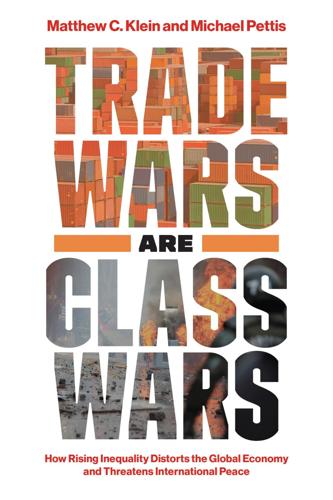
Trade Wars Are Class Wars: How Rising Inequality Distorts the Global Economy and Threatens International Peace
by
Matthew C. Klein
Published 18 May 2020
Kenneth Austin, “Communist China’s Capitalism: The Highest Stage of Capitalist Imperialism,” World Economics, January–March 2011, 79–94. ONE From Adam Smith to Tim Cook 1. Adam Smith, An Inquiry into the Nature and Causes of the Wealth of Nations, 2 vols., ed. Edwin Cannan (London: Methuen, 1904), vol. 1, bk. 1, chap. 1, available at https://oll.libertyfund.org/. 2. R. H. Coase, “The Nature of the Firm,” Economica 4, no. 16 (November 1937): 386–405. 3. Smith, Wealth of Nations, vol. 1, bk. 4, chap. 2. 4. David Ricardo, On the Principles of Political Economy and Taxation, 3rd ed. (London: John Murray, 1821), chaps. 7, 27, available at https://oll.libertyfund.org/. 5. Ricardo, Principles, chap. 7. 6.
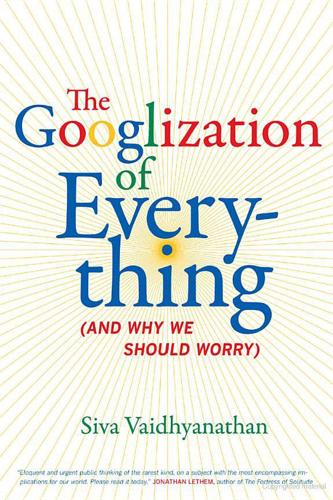
The Googlization of Everything:
by
Siva Vaidhyanathan
Published 1 Jan 2010
John Battelle, The Search: How Google and Its Rivals Rewrote the Rules of Business and Transformed Our Culture (New York: Portfolio, 2005). 19. Yochai Benkler, The Wealth of Networks: How Social Production Transforms Markets and Freedom (New Haven, CT: Yale University Press, 2006). 20. Yochai Benkler, “Coase’s Penguin, or, Linux and the Nature of the Firm,” Yale Law Journal 112, no. 3 (2002): 369–446. 21. Daniel O. O’Connor and Henry Voos, “Laws, Theory Construction and Bibliometrics,” Library Trends 30, no. 1 (1981): 9–20; see also Christine Kosmopoulos and Denis Pumain, “Citation, Citation, Citation: Bibliometrics, the Web and the Social Sciences and Humanities,” Cybergeo: European Journal of Geography 411 (December 17, 2007), www.cybergeo.eu.
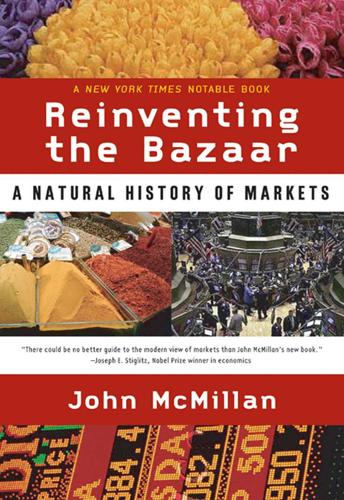
Reinventing the Bazaar: A Natural History of Markets
by
John McMillan
Published 1 Jan 2002
“Internet Tomography,” Nature (January 7). http://helix.nature.com/webmatters/tomog/tomog.html. Clark, Gracia. 1988. “Price Control of Local Foodstuffs in Kumasi, Ghana, 1979.” In G. Clark, ed., Traders versus the State: Anthropological Approaches to Unofficial Economies. Boulder, Colo., Westview Press. Coase, R. H. 1937. “The Nature of the Firm.” Economica 4, 386–405. ————. 1960. “The Problem of Social Cost.” Journal of Law and Economics 3, 1–44. Cockburn, Iain, and Henderson, Rebecca. 1997. “Public-Private Interaction and the Productivity of Pharmaceutical Research” Working paper no. 6018, National Bureau Economic Research, Cambridge, Mass.
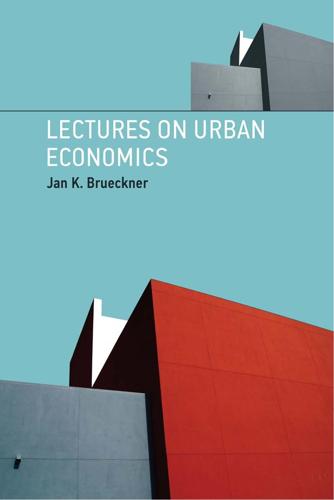
Lectures on Urban Economics
by
Jan K. Brueckner
Published 14 May 2011
As inputs, these firms use labor and “real estate,” which corresponds to the floor space contained in factories and offices. Other inputs could be used as well, but as long as their prices are the same in all regions, these inputs can be ignored. Although consumers were portrayed as consuming housing, it is useful to think of this commodity more generally as real estate, matching the nature of the firm’s input. Thus, the analysis will portray both firms and individuals as consuming real estate, with the difference between residential and business real estate ignored for simplicity. As a result, the price p should now be viewed as the price per square foot of real estate, which is common across residential and business uses.
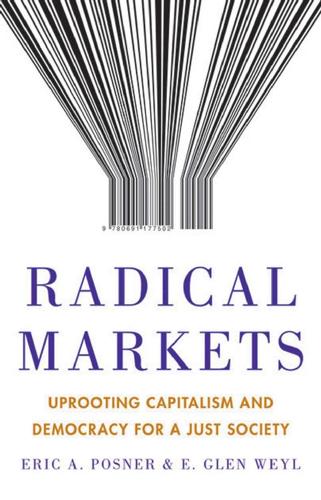
Radical Markets: Uprooting Capitalism and Democracy for a Just Society
by
Eric Posner
and
E. Weyl
Published 14 May 2018
Gareth Stedman Jones, Karl Marx—Greatness and Illusion (Belknap Press, 2016). 9. Michael Kremer, The O-Ring Theory of Economic Development, 108 Quarterly Journal of Economics 551 (1993), provides a definitive account of how large-scale enterprises typically must overcome monopoly problems. 10. R. H. Coase, The Nature of the Firm, 4 Economica 386 (1937). 11. W. Stanley Jevons, The Theory of Political Economy xlvi (Macmillan and Company, 5th ed., 1957). 12. Léon Walras, Studies in Social Economics 224–225 (Jan van Daal & Donald A. Walker, trans., Routledge, 2010). 13. The term “social dividend” seems to have been coined by Oskar Lange, The Economic Theory of Socialism, 4 Review of Economic Studies 1 (1936), but he attributed the concept to Walras.
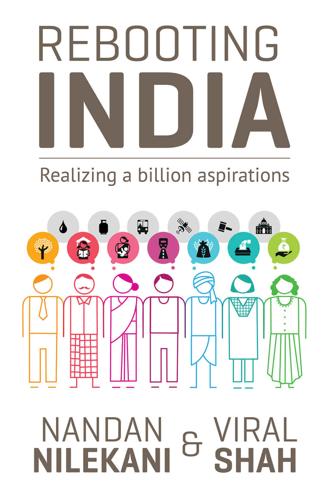
Rebooting India: Realizing a Billion Aspirations
by
Nandan Nilekani
Published 4 Feb 2016
By pooling the homes and spare bedrooms of thousands of people, Airbnb now has more rooms than the biggest hotel chains. In India, Oyo Rooms has achieved much the same with budget hotels. Flipkart and Amazon provide marketplaces where merchants sell just about anything to hundreds of millions of customers. In his pioneering article, ‘The Nature of the Firm’, written in 1937, the economist Ronald Coase argued that the costs of carrying out transactions—the costs of search and information, coordination and contracting—meant that it made better financial sense for people to organize themselves into firms. As the friction around these costs grew, firms themselves would keep expanding.
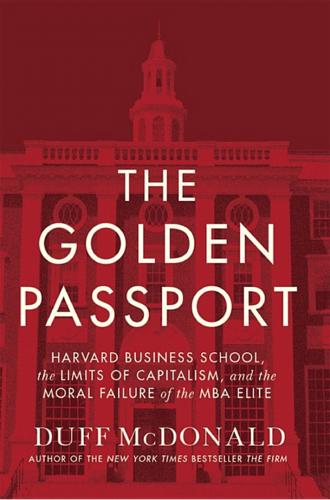
The Golden Passport: Harvard Business School, the Limits of Capitalism, and the Moral Failure of the MBA Elite
by
Duff McDonald
Published 24 Apr 2017
While it isn’t that difficult to see why management itself sees unions as “restricting and constricting,” one wonders why it must then follow that a professor of management must see unions in the same way. This is a crucial issue in the history of HBS. At some point, its faculty decided, consciously or not, that its job was not to continually question the nature of the firm or of management, but to simply accept them as given. The implications of that decision become obvious when Ewing articulates the late 1980s students’ point of view: “I remember one class where the consensus was clear that over the years unions have negotiated wage levels that far exceed the levels that would develop in a freely competitive workplace.
…
“The business schools conspired to accelerate this trend to ignore the big picture, wiping out the ‘general management’ syllabus and replacing it with specialist curricula. One interesting result is that none of the faculty bothers to claim to understand (or research) the firm as a whole. They thereby conspire to forget [Ronald Coase’s fundamental questions about the nature of the firm itself]—‘Why do firms exist?,’ ‘Why are their boundaries where they are?,’ ‘Why are their internal arrangements as they are?,’ and ‘Why is their performance so varied?’ Instead business school teachers happily presume answers to these questions and fiddle around at their edges and theorize marginal improvements.”8 It’s heady stuff, but it’s also incredibly important.
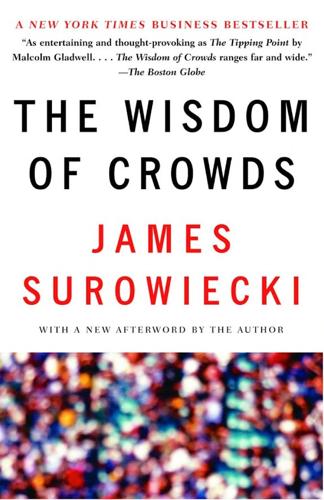
The Wisdom of Crowds
by
James Surowiecki
Published 1 Jan 2004
See Ronald Coase, The Firm, the Market, and the Law (Chicago: University of Chicago Press, 1988); the D. H. Robertson quote is on page 35. See also Oliver Williamson, Markets and Hierarchies: Analysis and Antitrust Implications (New York: The Free Press, 1975); Williamson, “Calculativeness, Trust, and Economic Organization,” Journal of Law and Economics 36 (1993): 453–86; and The Nature of the Firm, edited by Oliver Williamson and Sidney Winter (New York: Oxford University Press, 1991), which includes the original Coase essay. Alfred Chandler Jr.’s histories of the rise of corporate capitalism are essential. See Chandler, The Visible Hand (Cambridge: Belknap/Harvard University Press, 1977); and Chandler, Scale and Scope (Cambridge: Belknap/Harvard University Press, 1990).
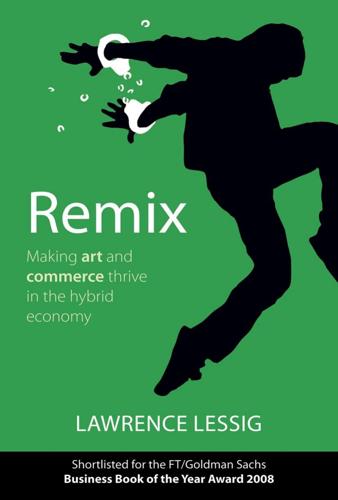
Remix: Making Art and Commerce Thrive in the Hybrid Economy
by
Lawrence Lessig
Published 2 Jan 2009
As Mary Madden summarizes the idea, it is “utilizing collective intelligence, providing networkenabled interactive services, giving users control over their own data.” Mary Madden and Susannah Fox, Riding the Waves of Web 2.0 (Washington, D.C.: Pew Internet Project, 2006), 1. 30. Ronald H. Coase, “The Nature of the Firm,” Economica 4 (1937): 386–405. 31. Benkler, The Wealth of Networks, 59–60. 32. Lawrence Lessig, The Future of Ideas (New York: Random House, 2001) 35–36. 33. Clayton M. Christensen, The Innovator’s Dilemma (Boston, Mass.: Harvard Business School Press, 1997), 228. 34. Benkler, “Sharing Nicely,” 282. 35.

Markets, State, and People: Economics for Public Policy
by
Diane Coyle
Published 14 Jan 2020
Amartya Sen (2017), Collective Choice and Social Welfare, expanded ed., Penguin. Hal Varian (2014), Intermediate Microeconomics: A Modern Approach, 9th ed., W. W. Norton. Classics Kenneth Arrow (1951), Social Choice and Individual Values, Wiley. Ronald Coase (1960), “The Problem of Social Cost,” Journal of Law and Economics 3: 1–44. Ronald Coase (1937), “The Nature of the Firm,” Economica 4: 386–405. Friedrich A. Hayek (1945), “The Use of Knowledge in Society,” American Economic Review 35, no. 4: 519–530. R. G. Lipsey and Kelvin Lancaster (1956), “The General Theory of Second Best,” Review of Economic Studies 24, no. 1: 11–32. Paul Samuelson (1947), Foundations of Economic Analysis, Harvard University Press, chapter 9.
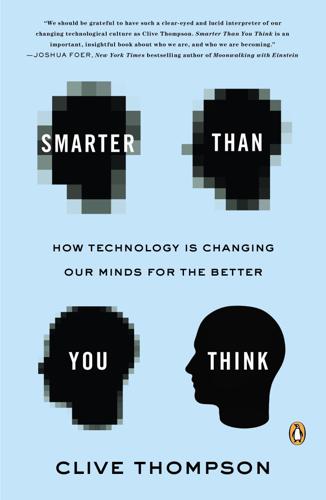
Smarter Than You Think: How Technology Is Changing Our Minds for the Better
by
Clive Thompson
Published 11 Sep 2013
To organize a widespread group around a task in the pre-Internet period, you needed a central office, staff devoted to coordinating efforts, expensive forms of long-distance communication (telegraphs, phone lines, trains), somebody to buy pencils and paper clips and to manage inventory. These are known as transaction costs, and they’re huge. But there was no way around them. As Shirky points out, following the analysis of economist Ronald Coase’s 1937 article “The Nature of the Firm,” you either paid the heavy costs of organizing or you didn’t organize at all and got nothing done. And so for centuries, people collaborated massively only on tasks that would make enough money to afford those costs. You could work together globally at building and selling profitable cars (like the Ford Motor Company) or running a world religion (like the Catholic Church), or even running a big nonprofit that could solicit mass donations (like UNICEF).

The Blockchain Alternative: Rethinking Macroeconomic Policy and Economic Theory
by
Kariappa Bheemaiah
Published 26 Feb 2017
Transactional cost theory (TCT) is the branch of economics that deals with the costs of transactions and the institutions that are developed to govern them. It studies the cost of economic links and the ways in which agents organize themselves to deal with economic interactions. Coase realized that economic transactions are costly. In his seminal paper, ‘The Nature of the Firm’, Coase noted that while economies involve plenty of planning, a large part of this planning is not coordinated by the price system and takes place within the boundaries of the firm (Hidalgo, 2015). As firms have hierarchies, most interactions within a firm are political. This creates boundaries of power that influence transactions and interactions causing them to deviate from the clear-cut dynamics of market price mechanisms.

The Code of Capital: How the Law Creates Wealth and Inequality
by
Katharina Pistor
Published 27 May 2019
But over time, the balance has tilted toward the latter. 11. Sanford J. Grossman and Oliver D. Hart, “The Costs and Benefits of Ownership: A Theory of Vertical and Lateral Integration,” Journal of Political Economy 94, no. 4 (1986):691–719; Oliver Hart, and John Moore, “Property Rights and the Nature of the Firm,” Journal of Political Economy 98, no. 6 (1990):1119–1158. 12. Katharina Pistor and Chenggang Xu, “Incomplete Law,” Journal of International Law and Politics 35, no. 4 (2003):931–1013. 13. On the rules vs. standards debate, see Louis Kaplow, “Rules versus Standards: An Economic Analysis,” Duke Law Journal 42 (1992):557–629. 14.
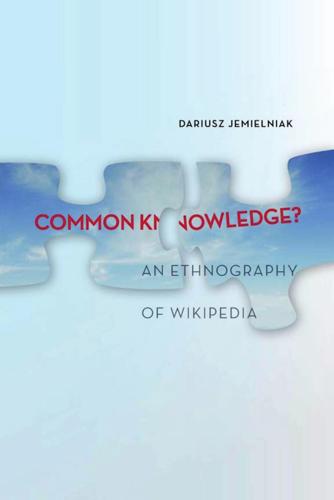
Common Knowledge?: An Ethnography of Wikipedia
by
Dariusz Jemielniak
Published 13 May 2014
Ethnography goes online: Towards a user-centred methodology to research interpersonal communication on the Internet. Qualitative Research, 11(6), 716–735. Benevolent dictator. (2013, April 27). Wikimedia. Retrieved August 23, 2013, from http:// meta.wikimedia.org/wiki/Benevolent_dictator Benkler, Y. (2002). Coase’s penguin, or, Linux and “the nature of the firm.” Yale Law Journal, 112(3), 369–446. Benkler, Y. (2006a). Extracting signal from noisy spin. The Edge. Retrieved from http:// www.edge.org/discourse/digital_maoism.html Benkler, Y. (2006b). The wealth of networks: How social production transforms markets and freedom. New Haven, CT: Yale University Press.
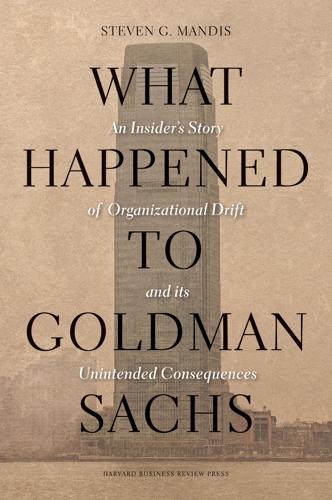
What Happened to Goldman Sachs: An Insider's Story of Organizational Drift and Its Unintended Consequences
by
Steven G. Mandis
Published 9 Sep 2013
The idea of a corporate culture having the characteristics of religious belief only works as a kind of general parallel. And my use of religious terms or phrases should be understood only as analogy, to help explain the ethos. Employees at Goldman do even often use religious terms to describe the nature of the firm’s work, and there is the element of something like blind allegiance, or faith, in the devotion of employees to the firm. A religious-like work ethic is an important force behind Goldman’s relentless pursuit of excellence and its people’s devotion. Goldman’s atmosphere is one in which the pursuit of excellence is seen as the good and right thing to do, and its success (including economic gain) is well deserved.
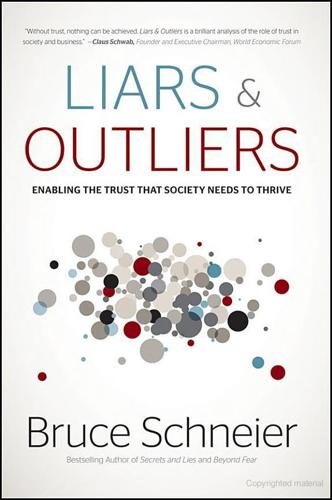
Liars and Outliers: How Security Holds Society Together
by
Bruce Schneier
Published 14 Feb 2012
used to be smaller John Stopford (1998), “Multinational Corporations,” Foreign Policy, 113:12–24. Gardiner C. Means (1931), “The Growth in the Relative Importance of the Large Corporation in American Economic Life,” The American Economic Review, 21:10–42. Ronald Coase first Ronald Coase (1937), “The Nature of the Firm,” Economica, 4:386–405. Nick Leeson's Richard W. Stevenson (28 Feb 1995), “The Collapse of Barings: The Overview: Young Trader's $29 Billion Bet Brings down a Venerable Firm,” New York Times. Erik Ipsen (19 Jul 1995), “Bank of England Cites Fraud in Barings Collapse,” New York Times. Peter Culshaw (8 Jan 2009), “Nick Leeson: How the Original Rogue Trader at Barings Bank Is Thriving in the Credit Crunch,” The Telegraph.

Culture and Prosperity: The Truth About Markets - Why Some Nations Are Rich but Most Remain Poor
by
John Kay
Published 24 May 2004
Rome: Food and Agriculture Organization of the United Nations. Williamson, 0. E. 1975. Markets and Hierarchies. New York: Free Press. ---. 1985. The Economic Institutions of Capitalism: Firms, Markets, Relational Contracting. New York: Free Press. Williamson, 0. E., and S. G. Winter, eds. 1991. The Nature of the Firm: Origins, Evolution and Development. New York: Oxford University Press. Wilson, E. 0. 1971. The Insect Societies. Cambridge, Mass.: Harvard University Press. ---. 1975. Sociobiology, the New Synthesis. Cambridge, Mass.: Belknap Press of Harvard University Press. WM Company. 2002. A Comparison of Active and Passive Management of Unit Trusts.

Adam Smith: Father of Economics
by
Jesse Norman
Published 30 Jun 2018
Minsky in John Maynard Keynes, McGraw-Hill [1975] 2008 Different definitions of economics: as ‘the science which studies human behaviour as a relationship between given ends and scarce means’, see Lionel Robbins, An Essay on the Nature and Significance of Economic Science, Macmillan 1932; as the study of incentives, see Steve Levitt and Stephen Dubner, Freakonomics: A Rogue Economist Explores the Hidden Side of Everything, HarperCollins 2005 Centrality of institutions to economic life: for the firm as economic institution, see Ronald Coase, ‘The Nature of the Firm’, Economica, 4.16, 1937. More widely, see e.g. Douglass North, ‘Institutions’, Journal of Economic Perspectives, 5.1, Winter 1991, which includes North’s own sketch of a stadial history of market evolution, and analysis of non-evolution. For an argument that economic ideology has corrosive effects on institutions, see Stephen Marglin, The Dismal Science: How Thinking Like an Economist Undermines Community, Harvard University Press 2008 Smith and Marx: see e.g.
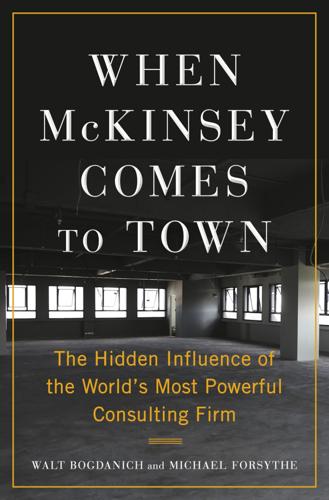
When McKinsey Comes to Town: The Hidden Influence of the World's Most Powerful Consulting Firm
by
Walt Bogdanich
and
Michael Forsythe
Published 3 Oct 2022
In Indonesia, the world’s second-biggest coal exporter after Australia, McKinsey has recently counted two major coal miners as clients, and the firm also works with PT Pertamina, Indonesia’s second-biggest oil producer. The work, at odds with McKinsey’s public statements on the urgency of combating climate change, speaks to the nature of the firm itself: at McKinsey, the senior partners, scattered across the globe, have called the shots on business in their area. By 2021, Dickon Pinner’s thesis on the magic of the market cutting pollution, argued so poignantly at Aspen two years and more than sixty gigatons of greenhouse gas emissions earlier, was proving woefully inadequate.

The Future of the Internet: And How to Stop It
by
Jonathan Zittrain
Published 27 May 2009
Today we have close to 1,000,000 users and 100,000 projects.”). As of September 2007, the SourceForge front page reported that there were 158,761 projects. SourceForge.net, http://sourceforge.net (last visited Sep. 29, 2007). 45. See generally Yochai Benkler, Coase’s Penguin, or, Linux and the Nature of the Firm, 112 YALE L.J. 369, 371 (2002) (“At the heart of the economic engine of the world’s most advanced economies,… we are beginning to take notice of a hardy, persistent, and quite amazing phenomenon. A new model of production has taken root, one that should not be there, at least according to our most widely held beliefs about economic behavior.

The Zero Marginal Cost Society: The Internet of Things, the Collaborative Commons, and the Eclipse of Capitalism
by
Jeremy Rifkin
Published 31 Mar 2014
Magazine, June 30, 2001, http://www.yes magazine.org/issues/reclaiming-the-commons/the-hidden-commons (accessed June 16, 2013). 42. Mike Bergan, “The American Commons,” 10,000 Birds, August 6, 2007, http://10000birds .com/the-american-commons.htm (accessed July 2, 2013). 43. Yochai Benkler, “Coase’s Penguin, or, Linux and The Nature of the Firm,” Yale Law Journal 112(369) v.04.3 (August 2002): 1–2, http://www.benkler.org/CoasesPenguin.PDF (accessed June 26, 2013). 44. Peter Barnes, Capitalism 3.0: A Guide to Reclaiming the Commons (San Francisco: Berrett-Koehler Publishers, 2006), xiv. Chapter 12 1. Yochai Benkler, The Wealth of Networks: How Social Production Transforms Markets and Freedom (New Haven, CT: Yale University Press, 2006), 470. 2.

Why We Can't Afford the Rich
by
Andrew Sayer
Published 6 Nov 2014
Aggressive cost cutting – including job cutting – took priority over long-term investment. Wealth extraction outweighed long-term wealth creation. In the US, it was only the top 2% who had a significant share of this non-wage income.31 Whatever the consequences, the shareholders had to be fed. The shareholder value movement changed the nature of the firms. Instead of coherent groups of activities required for producing particular goods and services for profit, companies came to be treated as bundles of assets to be bought, dismembered and sold off in pieces, in whatever way delivered short-term profits for shareholders. It’s tempting to liken the situation to a protection racket in which those who do not pay their protectors enough face the threat of being taken over by other, more demanding protectors.
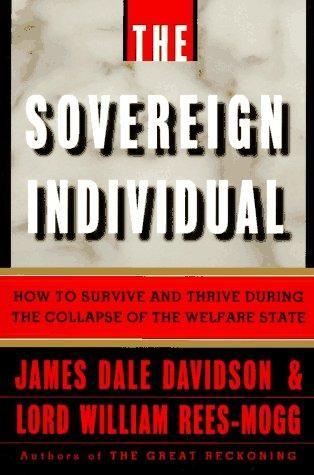
The Sovereign Individual: How to Survive and Thrive During the Collapse of the Welfare State
by
James Dale Davidson
and
William Rees-Mogg
Published 3 Feb 1997
Country: Tom Peters & George Gilder Debate the Impact of Technology on Location," Forbes, February 1995. 18. Weber, op. cit., p.21. 19. Ibid., p.46 for London, p.73 for Paris. 20. Ibid., p.120. 21. Ibid., p.95. 22. Ibid., p.84. 23. Ibid., p.119. 24. Ibid., p.101. 25. Ibid., p.5. 26. See Ronald Coase, "The Nature of the Firm," reprinted in Louis Putterman and Randall S. Kroszner, eds., The Economic Nature of the Firm: A Reader 2nd ed. (Cambridge: Cambridge University Press, 1996), pp.89-104. 27. Quoted by West, op. cit., p.58; see also Oliver E. Williamson, "The Organization of Work: A Comparative Insititutional Assessment," Journal of Economic Behaviour and Organisation, vol.1, no.1. 28.
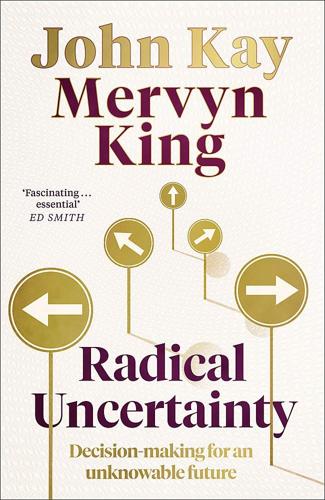
Radical Uncertainty: Decision-Making for an Unknowable Future
by
Mervyn King
and
John Kay
Published 5 Mar 2020
K., ‘Reconceptualizing the Burden of Proof’, Yale Law Journal , Vol. 122, No. 5 (2013), 1254–79 Chong, K. and Tuckett, D., ‘Constructing Conviction Through Action and Narrative: How Money Managers Manage Uncertainty and the Consequences for Financial Market Functioning’, Socio-Economic Review , Vol. 13, No. 2 (2015), 1–26 Christoffel, K., Coenen, G. and Warne, A., ‘Forecasting with DSGE Models’, ECB Working Paper Series , No. 1185 (2010) Churchill, W., The Second World War, Volume II (London: The Reprint Society, 1949) Clapham, J. H., Bibliography of English Economic History (London: Historical Association, 1913) Clausewitz, K., Howard, M. and Paret, P. (trans.), On War (Princeton: PUP, 1976) Coase, R., ‘The Nature of the Firm’, Economica , Vol. 4, No. 16 (1937), 386–405 Coase, R., ‘Opening Address to the Annual Conference’, International Society of New Institutional Economics, Washington DC (17 Sept 1999) < http://www.coase.org/coasespeech.htm > (accessed 16 May 2018) Cochrane, J. H., ‘How did Paul Krugman Get it so Wrong?’

Superintelligence: Paths, Dangers, Strategies
by
Nick Bostrom
Published 3 Jun 2014
A Farewell to Alms: A Brief Economic History of the World. 1st ed. Princeton, NJ: Princeton University Press. Clavin, Whitney. 2012. “Study Shows Our Galaxy Has at Least 100 Billion Planets.” Jet Propulsion Laboratory, January 11. CME Group. 2010. What Happened on May 6th? Chicago, May 10. Coase, R. H. 1937. “The Nature of the Firm.” Economica 4 (16): 386–405. Cochran, Gregory, and Harpending, Henry. 2009. The 10,000 Year Explosion: How Civilization Accelerated Human Evolution. New York: Basic Books. Cochran, G., Hardy, J., and Harpending, H. 2006. “Natural History of Ashkenazi Intelligence.” Journal of Biosocial Science 38 (5): 659–93.
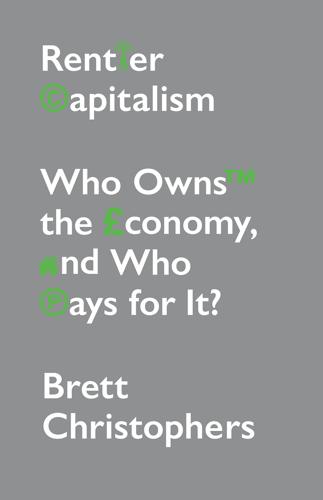
Rentier Capitalism: Who Owns the Economy, and Who Pays for It?
by
Brett Christophers
Published 17 Nov 2020
Peck, Offshore: Exploring the Worlds of Global Outsourcing (Oxford: Oxford University Press, 2017). 13. Weber, ‘End of Employees’. 14. U. Huws and S. Podro, ‘Outsourcing and the Fragmentation of Employment Relations: The Challenges Ahead’, August 2012, p. 5 – pdf available at acas.org.uk. 15. Ibid., p. 9. 16. B. Beyazay-Odemis, The Nature of the Firm in the Oil Industry: International Oil Companies in Global Business (New York: Routledge, 2016), pp. 32–6. 17. E. Crooks, ‘BP Raises Pressure on Key Suppliers’, Financial Times, 8 February 2009. 18. A. West and D. Wolfe, ‘Academies, the School System in England and a Vision for the Future’, June 2018, p. 4 – pdf available at lse.ac.uk. 19.

Aerotropolis
by
John D. Kasarda
and
Greg Lindsay
Published 2 Jan 2009
The trend is to keep going, flinging ourselves ever farther into space, until we scatter completely, forming what Melvin Webber might have called companies without propinquity—maybe the next step in corporate evolution. Corporations have struggled with how and where to best arrange themselves since Henry Ford built the world’s biggest factory outside Detroit, then changed his mind and started taking it apart. In 1937, the economist Ronald Coase wrote “The Nature of the Firm,” exploring just how big a vertically integrated one like Ford’s might get. Not much bigger, he argued, because beyond a certain point, the drag of managing huge organizations over long distances would offset any advantages of scale. Size mattered, however, if advances in transportation, communication, and management techniques could shrink these distances and di-minish the drag.
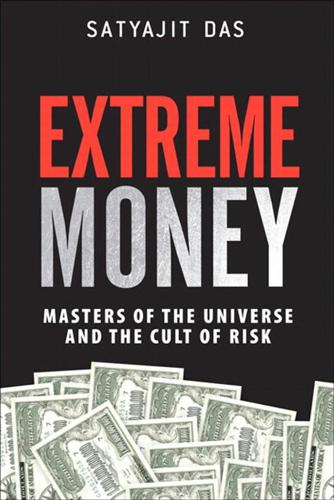
Extreme Money: Masters of the Universe and the Cult of Risk
by
Satyajit Das
Published 14 Oct 2011
GE was increasingly a product of financial engineering. The size and complex structure of GE made it difficult to understand and analyze—should GE be classified as an industrial or a financial firm? GE studiously maintained a constructive ambiguity, increasing the lack of transparency and making detailed like-for-like comparisons difficult. The nature of the firm made the relatively few investment analysts who covered the company reliant on management, especially Welch, who was GE’s best share salesman. In analyst briefings, Welch typically replied to questions identifying each analyst by their first name. As The Economist noted: “[GE treats] analysts, journalists and other outsiders as if they either belong to the family and are believers, or do not.”22 Investors, reassured by a word from Jack and the company’s capability to meet or marginally beat carefully cultivated earnings expectations, bought GE shares unquestioningly.
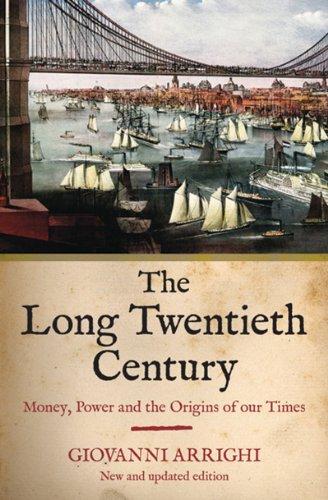
The Long Twentieth Century: Money, Power, and the Origins of Our Times
by
Giovanni Arrighi
Published 15 Mar 2010
Cipolla, Carlo M., “The Decline of Italy,” Economic History Review, 5, 2, 1952, pp.178-87. Guns and Sails in the Early Phase of European Expansion 1400-1700, London: Collins 1965. Before the Industrial Revolution. European Society and Economy, 1000-1700, New York: Norton 1980. Coase, Richard, “The Nature of the Firm,” Economica (n.s.) 4, 15, 1937, pp. 386-405. Cohen, Benjamin J., Organizing t/re 1%rld ’s Money, New York: Basic Books 1977. Cohen, Jerome B.,]apan’s Postwar Economy, Bloomington, IN: Indiana University Press 1958. Copeland, Melvin Thomas, 77Je Cotton Manufizcturing Industry of the United States, New York: Augustus M.

Slouching Towards Utopia: An Economic History of the Twentieth Century
by
J. Bradford Delong
Published 6 Apr 2020
Maier, “Between Taylorism and Technocracy: European Ideologies and the Vision of Industrial Productivity in the 1920s,” Journal of Contemporary History 5, no. 2 (1970): 27–61. 3. Martin Weitzman, “Prices Versus Quantities,” Review of Economic Studies 41, no. 4 (October 1974): 477–491. 4. Ronald Coase, “The Nature of the Firm,” Economica 4, no. 16 (1937): 386–405. 5. Janos Kornai, The Economics of Shortage, Amsterdam: North-Holland, 1979. 6. Consider Chicago School of Economics cofounder Henry Simons, with his belief that the trust-busting Federal Trade Commission ought to be the most important and most activist arm of the government.
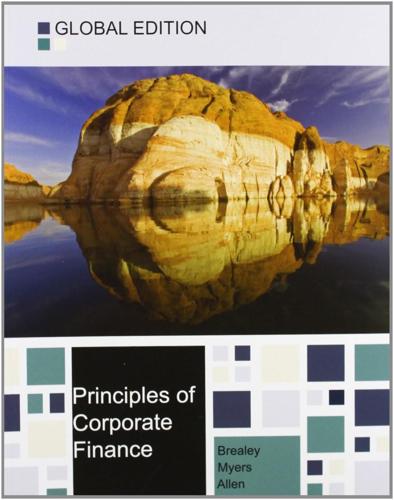
Principles of Corporate Finance
by
Richard A. Brealey
,
Stewart C. Myers
and
Franklin Allen
Published 15 Feb 2014
For example, Bertrand and Schoar tracked the careers of individual CEOs, CFOs, and other top managers. Their individual “styles” persisted as they moved from firm to firm.32 For example, older CEOs tended to be more conservative and pushed their firms to lower debt. CEOs with MBA degrees tended to be more aggressive. In general, financial decisions depended not just on the nature of the firm and its economic environment, but also on the personalities of the firm’s top management. The Bright Side and the Dark Side of Financial Slack Other things equal, it’s better to be at the top of the pecking order than at the bottom. Firms that have worked down the pecking order and need external equity may end up living with excessive debt or passing by good investments because shares can’t be sold at what managers consider a fair price.
…
● ● ● ● ● SUMMARY Short-term financial planning is concerned with the management of the firm’s short-term, or current, assets and liabilities. The most important current assets are cash, marketable securities, accounts receivable, and inventory. The most important current liabilities are short-term loans and accounts payable. The difference between current assets and current liabilities is called net working capital. The nature of the firm’s short-term financial planning problem is determined by the amount of long-term capital it raises. A firm that issues large amounts of long-term debt or common stock, or that retains a large part of its earnings, may find it has permanent excess cash. In such cases there is never any problem paying bills, and short-term financial planning consists of managing the firm’s portfolio of marketable securities.

Capital in the Twenty-First Century
by
Thomas Piketty
Published 10 Mar 2014
Obviously, such an estimate would be highly approximate, with a margin of error much greater than the maximum salary one would think of paying, even in a totally stable economic environment.34 And the whole idea of experimentation looks even more hopeless when one remembers that the environment is in fact changing constantly, as is the nature of the firm and the exact definition of each job. In view of these informational and cognitive difficulties, how are such remunerations determined in practice? They are generally set by hierarchical superiors, and at the very highest levels salaries are set by the executives themselves or by corporate compensation committees whose members usually earn comparable salaries (such as senior executives of other large corporations).
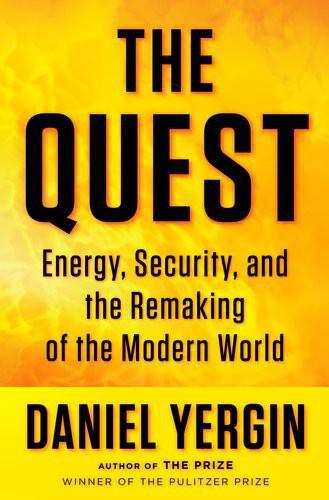
The Quest: Energy, Security, and the Remaking of the Modern World
by
Daniel Yergin
Published 14 May 2011
In 1951, he emigrated to the United States.2 Four decades later, in 1991, at age 81, he received the Nobel Prize in economics, mostly for two enormously influential articles. For the work of a Nobel Prize winner in economics, both articles were strikingly devoid of any mathematics save simple arithmetic. But they were very powerful in their arguments. In one, “The Nature of the Firm” published in 1937, Coase took on a very basic question—why do people coalesce into companies in a market economy rather than remain as freelancers in a sea of the self-employed? The answer, he said, was “transaction costs”—costs are lower within companies, things are easier to get done, and efficiency is higher.
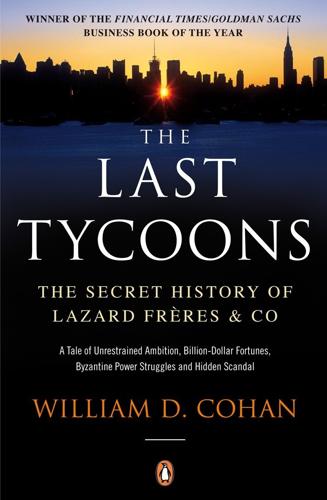
The Last Tycoons: The Secret History of Lazard Frères & Co.
by
William D. Cohan
Published 25 Dec 2015
Felix and Michel wrote that Lazard had a finite "window of opportunity" to exploit the unresolved internal problems of larger firms and the still evolving role to be played by several emerging advisory boutiques. "We need to address successfully difficult issues of organization, priorities, allocation of scarce resources, new undertakings, momentum and accountability for performance," they continued. "Without fundamentally changing the nature of the Firm, a more formal process and some centralization of authority are required to achieve our banking objectives." With that, Loomis became the firm's first official head of investment banking. To be fair, through the Andre years, of course, others such as Felix, Frank Pizzitola, and George Ames had loosely held the reins of the firm's advisory business.